₹49.00
Share with your Friends
IGNOU BBYET-141 Assignment Question Paper 2024
bbyet-141-solved-assignment-2024-qp-8648076a-dc1c-446a-986b-96f21861d046
- Describe the structure, composition and functions of mitochondria along with suitable diagram.
- Explain the concept of Operon. Describe their role in gene regulation along with suitable diagram.
- a) Discuss the factors that determine the resolving power of a microscope.
b) Differentiate between transmission and scanning electron microscopes. - a) Discuss the mechanisms involved in gene silencing by RNA interference.
b) Compare the process of DNA replication in prokaryotes and eukaryotes. - a) Discuss the common features of chloroplast and mitochondrial DNA with labelled diagram.
b) Discuss the role of Cdk’s during cell cycle progression. - List various components of nucleus. Describe the structure of "nuclear pore complex’ with the help of neat labelled diagram.
- Describe various stage of Meiosis I and II with the help of suitable diagram.
- a) Discuss the ErvinChargaff’s Rule.
b) Give an outline of polypeptide synthesis in bacteria. - Describe Griffith’s experiment for demonstration of DNA as a genetic material with suitable diagram.
- Write short notes on the following:
i) Peroxixomes
ii) Golgi apparatus
iii) Telomerase enzyme
iv) Endosymbiotic Theory
BBYET-141 Sample Solution 2024
bbyet-141-solved-assignment-2024-ss-8648076a-dc1c-446a-986b-96f21861d046
- Describe the structure, composition and functions of mitochondria along with suitable diagram.
- Outer Membrane: The outer membrane is the smooth, semi-permeable outer layer of the mitochondrion. It contains numerous proteins, including porins, that allow the passage of small molecules and ions.
- Intermembrane Space: The space between the outer and inner membranes is called the intermembrane space. It contains enzymes involved in certain metabolic reactions.
- Inner Membrane: The inner membrane is a highly folded, convoluted membrane that forms numerous projections called cristae. The inner membrane is impermeable to most ions and molecules and is the site of many critical metabolic reactions.
- Cristae: Cristae are the infoldings or inner folds of the inner mitochondrial membrane. They provide a large surface area for enzymes involved in oxidative phosphorylation, the process by which ATP (adenosine triphosphate) is produced.
- Matrix: The matrix is the central compartment enclosed by the inner mitochondrial membrane. It contains enzymes responsible for the Krebs cycle (citric acid cycle) and fatty acid oxidation, both of which play vital roles in cellular respiration.

- Phospholipid Bilayers: Like all cellular membranes, mitochondria have phospholipid bilayers that form the outer and inner membranes.
- Proteins: Mitochondria contain a variety of proteins, including those involved in energy production, transport of molecules across membranes, and enzymes for metabolic pathways.
- DNA (Mitochondrial DNA or mtDNA): Mitochondria contain their own small circular DNA molecules (mtDNA), which carry genes encoding some of the proteins needed for mitochondrial function. This is a relic of their evolutionary history as free-living bacteria.
- Ribosomes: Mitochondria have their own ribosomes, similar to bacterial ribosomes. These ribosomes are involved in protein synthesis within the mitochondria.
- ATP Production: Mitochondria produce ATP through a process called oxidative phosphorylation. This involves the electron transport chain, which transfers electrons through protein complexes on the inner mitochondrial membrane, creating a proton gradient. The flow of protons back into the matrix through ATP synthase generates ATP.
- Krebs Cycle: Mitochondria host the Krebs cycle (also known as the citric acid cycle or TCA cycle), which is a central metabolic pathway that oxidizes acetyl-CoA derived from carbohydrates, fats, and proteins. This cycle generates high-energy electron carriers (NADH and FADH2) for the electron transport chain.
- Fatty Acid Oxidation: Mitochondria are involved in the oxidation of fatty acids, breaking them down to produce energy.
- Calcium Regulation: Mitochondria play a role in regulating intracellular calcium levels, which are critical for cell signaling and muscle contraction.
- Apoptosis: Mitochondria are involved in the regulation of apoptosis (programmed cell death). Release of specific proteins from the intermembrane space can trigger apoptosis.
- Heat Production: In specialized brown adipose tissue, mitochondria can generate heat through a process called thermogenesis. This is essential for temperature regulation in some animals, including newborns.
- Explain the concept of Operon. Describe their role in gene regulation along with suitable diagram.
- Structural Genes: These are the genes that encode proteins with related functions. They are transcribed together as a single mRNA molecule and are typically involved in a specific metabolic pathway.
- Promoter Region: Located upstream of the structural genes, the promoter region is a DNA sequence where RNA polymerase binds to initiate transcription.
- Operator Region: The operator is a DNA sequence situated between the promoter and the structural genes. It acts as a regulatory region where a protein called the repressor can bind.
- Regulatory Gene: This gene encodes the repressor protein. It is located either adjacent to the operon or at a distant location in the genome.
- Repressor Protein: The regulatory gene encodes a repressor protein that can bind to the operator region. When the repressor is bound to the operator, it physically blocks RNA polymerase from binding to the promoter.
- Inducer Molecule: In many operons, the repressor’s ability to bind to the operator is regulated by the presence of an inducer molecule. The inducer can bind to the repressor, causing a conformational change in the repressor protein, making it unable to bind to the operator.
- Activation and Repression: Depending on the operon type, the presence or absence of the inducer molecule determines whether transcription of the structural genes occurs:
- Inducible Operon: In the absence of the inducer, the repressor binds to the operator, blocking transcription (repression). When the inducer is present, it binds to the repressor, releasing it from the operator, allowing transcription to occur (activation).
- Repressible Operon: In the presence of the co-repressor molecule (usually a product of the pathway), the repressor is activated and binds to the operator, preventing transcription. When the co-repressor is absent, the repressor cannot bind to the operator, allowing transcription (de-repression).

- The promoter is where RNA polymerase binds to initiate transcription.
- The structural genes encode proteins with related functions.
- The operator is a regulatory region where the repressor protein can bind.
- The regulatory gene encodes the repressor protein.
- The repressor protein can bind to the operator and block transcription.
- The presence or absence of an inducer molecule determines whether the repressor is active or inactive.
- Lac Operon: The lac operon in E. coli controls the metabolism of lactose. It is an inducible operon regulated by the presence of lactose and the inducer molecule allolactose.
- Trp Operon: The trp operon in E. coli controls the synthesis of tryptophan. It is a repressible operon regulated by the presence of tryptophan as a co-repressor.
Frequently Asked Questions (FAQs)
You can access the Complete Solution through our app, which can be downloaded using this link:
Simply click “Install” to download and install the app, and then follow the instructions to purchase the required assignment solution. Currently, the app is only available for Android devices. We are working on making the app available for iOS in the future, but it is not currently available for iOS devices.
Yes, It is Complete Solution, a comprehensive solution to the assignments for IGNOU. Valid from January 1, 2023 to December 31, 2023.
Yes, the Complete Solution is aligned with the IGNOU requirements and has been solved accordingly.
Yes, the Complete Solution is guaranteed to be error-free.The solutions are thoroughly researched and verified by subject matter experts to ensure their accuracy.
As of now, you have access to the Complete Solution for a period of 6 months after the date of purchase, which is sufficient to complete the assignment. However, we can extend the access period upon request. You can access the solution anytime through our app.
The app provides complete solutions for all assignment questions. If you still need help, you can contact the support team for assistance at Whatsapp +91-9958288900
No, access to the educational materials is limited to one device only, where you have first logged in. Logging in on multiple devices is not allowed and may result in the revocation of access to the educational materials.
Payments can be made through various secure online payment methods available in the app.Your payment information is protected with industry-standard security measures to ensure its confidentiality and safety. You will receive a receipt for your payment through email or within the app, depending on your preference.
The instructions for formatting your assignments are detailed in the Assignment Booklet, which includes details on paper size, margins, precision, and submission requirements. It is important to strictly follow these instructions to facilitate evaluation and avoid delays.
Terms and Conditions
- The educational materials provided in the app are the sole property of the app owner and are protected by copyright laws.
- Reproduction, distribution, or sale of the educational materials without prior written consent from the app owner is strictly prohibited and may result in legal consequences.
- Any attempt to modify, alter, or use the educational materials for commercial purposes is strictly prohibited.
- The app owner reserves the right to revoke access to the educational materials at any time without notice for any violation of these terms and conditions.
- The app owner is not responsible for any damages or losses resulting from the use of the educational materials.
- The app owner reserves the right to modify these terms and conditions at any time without notice.
- By accessing and using the app, you agree to abide by these terms and conditions.
- Access to the educational materials is limited to one device only. Logging in to the app on multiple devices is not allowed and may result in the revocation of access to the educational materials.
Our educational materials are solely available on our website and application only. Users and students can report the dealing or selling of the copied version of our educational materials by any third party at our email address (abstract4math@gmail.com) or mobile no. (+91-9958288900).
In return, such users/students can expect free our educational materials/assignments and other benefits as a bonafide gesture which will be completely dependent upon our discretion.
Related products

IGNOU MEG-06 Solved Assignment 2022-2023 | MEG | AMERICAN LITERATURE
₹101.00Please read the following points before ordering this IGNOU Assignment Solution.

IGNOU MEG-02 Solved Assignment 2022-2023 | MEG | British Drama
₹101.00Please read the following points before ordering this IGNOU Assignment Solution.
Categories: IGNOU Assignment Solution, MA MEG, MA MEG 2022-2023 Tags: "IGNOU, 2022-2023, 2023 assignments, Accurate, British Drama, Distance Education, Expert-written, IGNOU assignments, IGNOU course materials, IGNOU distance learning, IGNOU Solutions, IGNOU Students, IGNOU study materials, IGNOU study resources., Indira Gandhi National Open University, MEG, MEG-02, Online Learning, PG Diploma in Arts (English)", PGDAST, Solved Assignment, Solved assignments, Study Material, Up-to-date
IGNOU MEG-01 Solved Assignment 2022-2023 | MEG | British Poetry
₹101.00Please read the following points before ordering this IGNOU Assignment Solution.
Categories: IGNOU Assignment Solution, MA MEG, MA MEG 2022-2023 Tags: British Poetry, British poetry analysis, expert-written assignments, IGNOU assignments, IGNOU course materials, IGNOU distance education., IGNOU education, IGNOU exams, IGNOU MEG-01 Solved Assignment 2022-2023, IGNOU online learning, IGNOU resources, IGNOU student support, IGNOU study materials, MEG, MEG-01 assignment solutions, solved IGNOU assignments
IGNOU MST-001 Solved Assignment 2023 | PGDAST
₹351.00Access via our Android App Only
Please read the following points before ordering :
Categories: IGNOU Assignment Solution, PGDAST, PGDAST 2023 Tags: "IGNOU MST-001, Foundation in Mathematics and Statistics solved assignment Foundation in Mathematics and Statistics assignment solution, IGNOU Assignment, IGNOU Help, ignou pgdast assignment solution 2023, ignou pgdast solved assignment 2023, IGNOU PGDAST", IGNOU Solutions, IGNOU Study Material, mst-001 assignment solution, mst-001 assignment solution 2023, mst-001 solved assignment, mst-001 solved assignment 2023, mst001 assignment solution, mst001 assignment solution 2023, mst001 solved assignment, mst001 solved assignment 2023, mst01 assignment solution, mst01 assignment solution 2023, mst01 solved assignment, mst01 solved assignment 2023, mst1 assignment solution, mst1 assignment solution 2023, mst1 solved assignment, mst1 solved assignment 2023, PGDAST, Solved Assignment 2023

IGNOU MSTE-004 Previous Year Paper Solution | PGDAST
₹365.00Solved Papers – Dec 2022 to Dec 2023 (Total 3 Papers)
Access via our Android App or any Web browser.
Please read the following points before ordering :

IGNOU MSTE-003 Previous Year Paper Solution | PGDAST
₹365.00Solved Papers – Dec 2022 to Dec 2023 (Total 3 Papers)
Access via our Android App or any Web browser.
Please read the following points before ordering :
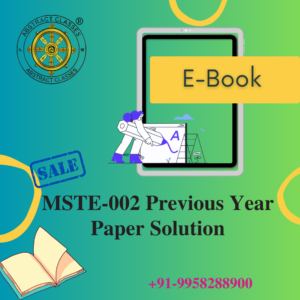
IGNOU MSTE-002 Previous Year Paper Solution | PGDAST
₹365.00Solved Papers – June 2015 to Dec 2023 (Total 18 Papers)
Access via our Android App or any Web browser.
Please read the following points before ordering :
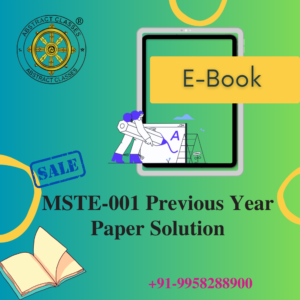
IGNOU MSTE-001 Previous Year Paper Solution | PGDAST
₹365.00Solved Papers – Dec 2015 to Dec 2023 (Total 17 Papers)
Access via our Android App or any Web browser.
Please read the following points before ordering :
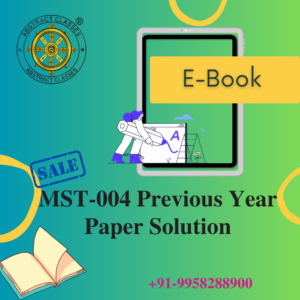
IGNOU MST-004 Previous Year Paper Solution | PGDAST
₹365.00Solved Papers – June 2015 to Dec 2023 (Total 18 Papers)
Access via our Android App or any Web browser.
Please read the following points before ordering :

IGNOU MST-019 Solved Assignment 2024 | MSCAST | IGNOU
₹365.00Access via our Android App Only
Please read the following points before ordering :

IGNOU MST-018 Solved Assignment 2024 | MSCAST | IGNOU
₹365.00Access via our Android App Only
Please read the following points before ordering :

IGNOU MST-017 Solved Assignment 2024 | MSCAST | IGNOU
₹365.00Access via our Android App Only
Please read the following points before ordering :

IGNOU MST-016 Solved Assignment 2024 | MSCAST | IGNOU
₹365.00Access via our Android App Only
Please read the following points before ordering :

IGNOU MPH-005 Solved Assignment 2024 | MSCPH | IGNOU
₹365.00Access via our Android App Only
Please read the following points before ordering :

IGNOU MPH-004 Solved Assignment 2024 | MSCPH | IGNOU
₹365.00Access via our Android App Only
Please read the following points before ordering :

IGNOU MPH-003 Solved Assignment 2024 | MSCPH | IGNOU
₹365.00Access via our Android App Only
Please read the following points before ordering :

IGNOU MPH-002 Solved Assignment 2024 | MSCPH | IGNOU
₹365.00Access via our Android App Only
Please read the following points before ordering :

IGNOU MPH-001 Solved Assignment 2024 | MSCPH | IGNOU
₹365.00Access via our Android App Only
Please read the following points before ordering :

IGNOU BZYET-143 Solved Assignment 2024 | B.Sc. CBCS Zoology
₹49.00Please read the following points before ordering this IGNOU Assignment Solution.

IGNOU BZYET-141 Solved Assignment 2024 | B.Sc. CBCS Zoology
₹49.00Please read the following points before ordering this IGNOU Assignment Solution.

IGNOU BZYCT-137 Solved Assignment 2024 | B.Sc. CBCS Zoology
₹49.00Please read the following points before ordering this IGNOU Assignment Solution.

IGNOU BZYCT-135 Solved Assignment 2024 | B.Sc. CBCS Zoology
₹49.00Please read the following points before ordering this IGNOU Assignment Solution.

IGNOU MMT-007 Solved Assignment 2024 | M.Sc. MACS
₹365.00Access via our Android App Only
Please read the following points before ordering :
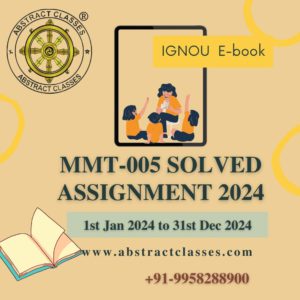
IGNOU MMT-005 Solved Assignment 2024 | M.Sc. MACS
₹365.00Access via our Android App Only
Please read the following points before ordering :

IGNOU MMT-004 Solved Assignment 2024 | M.Sc. MACS
₹365.00Access via our Android App Only
Please read the following points before ordering :

IGNOU MMT-002 Solved Assignment 2024 | M.Sc. MACS
₹365.00Access via our Android App Only
Please read the following points before ordering :

IGNOU MMT-001 Solved Assignment 2024 | M.Sc. MACS
₹365.00Access via our Android App Only
Please read the following points before ordering :

IGNOU MMT-008 Solved Assignment 2024 | M.Sc. MACS
₹365.00Access via our Android App Only
Please read the following points before ordering :
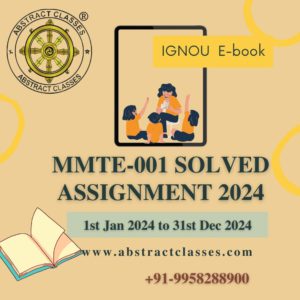
IGNOU MMTE-001 Solved Assignment 2024 | M.Sc. MACS
₹365.00Access via our Android App Only
Please read the following points before ordering :

IGNOU MMTE-002 Solved Assignment 2024 | M.Sc. MACS
₹365.00Access via our Android App Only
Please read the following points before ordering :

IGNOU MMT-009 Solved Assignment 2024 | M.Sc. MACS
₹365.00Access via our Android App Only
Please read the following points before ordering :
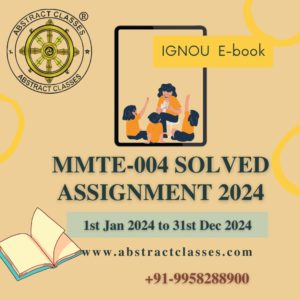
IGNOU MMTE-004 Solved Assignment 2024 | M.Sc. MACS
₹365.00Access via our Android App Only
Please read the following points before ordering :
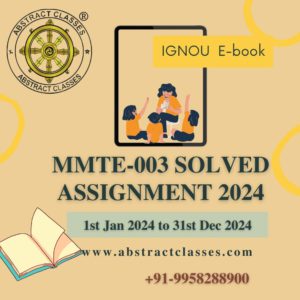
IGNOU MMTE-003 Solved Assignment 2024 | M.Sc. MACS
₹365.00Access via our Android App Only
Please read the following points before ordering :

IGNOU MMT-006 Solved Assignment 2024 | M.Sc. MACS
₹365.00Access via our Android App Only
Please read the following points before ordering :
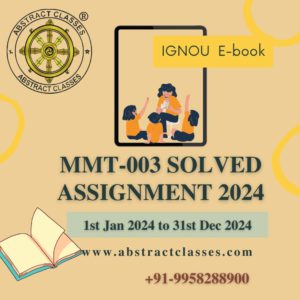
IGNOU MMT-003 Solved Assignment 2024 | M.Sc. MACS
₹365.00Access via our Android App Only
Please read the following points before ordering :

IGNOU BCHET-147 Solved Assignment 2024 | B.Sc. CBCS Chemistry
₹49.00Please read the following points before ordering this IGNOU Assignment Solution.

IGNOU BCHET-141 Solved Assignment 2024 | B.Sc. CBCS Chemistry
₹49.00Please read the following points before ordering this IGNOU Assignment Solution.

IGNOU BCHCT-137 Solved Assignment 2024 | B.Sc. CBCS Chemistry
₹49.00Please read the following points before ordering this IGNOU Assignment Solution.

IGNOU BCHCT-135 Solved Assignment 2024 | B.Sc. CBCS Chemistry
₹49.00Please read the following points before ordering this IGNOU Assignment Solution.

IGNOU BPHET-143 Solved Assignment 2024 | B.Sc (G) CBCS
₹101.00Please read the following points before ordering this IGNOU Assignment Solution.

IGNOU BPHET-141 Solved Assignment 2024 | B.Sc (G) CBCS
₹101.00Please read the following points before ordering this IGNOU Assignment Solution.

IGNOU BPHCT-137 Solved Assignment 2024 | B.Sc (G) CBCS
₹101.00Please read the following points before ordering this IGNOU Assignment Solution.

IGNOU BPHCT-135 Solved Assignment 2024 | B.Sc (G) CBCS
₹101.00Please read the following points before ordering this IGNOU Assignment Solution.

IGNOU BPHCT-133 Solved Assignment 2024 | B.Sc (G) CBCS
₹101.00Please read the following points before ordering this IGNOU Assignment Solution.

IGNOU BPHCT-131 Solved Assignment 2024 | B.Sc (G) CBCS
₹101.00Please read the following points before ordering this IGNOU Assignment Solution.

IGNOU BBYET-143 Solved Assignment 2024 | B.Sc. CBCS Botany
₹49.00Please read the following points before ordering this IGNOU Assignment Solution.

IGNOU BBYET-141 Solved Assignment 2024 | B.Sc. CBCS Botany
₹49.00Please read the following points before ordering this IGNOU Assignment Solution.

IGNOU BBYCT-137 Solved Assignment 2024 | B.Sc. CBCS Botany
₹49.00Please read the following points before ordering this IGNOU Assignment Solution.

IGNOU BBYCT-135 Solved Assignment 2024 | B.Sc. CBCS Botany
₹49.00Please read the following points before ordering this IGNOU Assignment Solution.

IGNOU BBYCT-133 Solved Assignment 2024 | B.Sc. CBCS Botany
₹49.00Please read the following points before ordering this IGNOU Assignment Solution.

IGNOU BBYCT-131 Solved Assignment 2024 | B.Sc. CBCS Botany
₹49.00Please read the following points before ordering this IGNOU Assignment Solution.

IGNOU BZYCT-133 Solved Assignment 2024 | B.Sc. CBCS Zoology
₹49.00Please read the following points before ordering this IGNOU Assignment Solution.

IGNOU BZYCT-131 Solved Assignment 2024 | B.Sc. CBCS Zoology
₹49.00Please read the following points before ordering this IGNOU Assignment Solution.

IGNOU BCHCT-133 Solved Assignment 2024 | B.Sc. CBCS Chemistry
₹49.00Please read the following points before ordering this IGNOU Assignment Solution.

IGNOU BCHCT-131 Solved Assignment 2024 | B.Sc. CBCS Chemistry
₹49.00Please read the following points before ordering this IGNOU Assignment Solution.

IGNOU BEGAE-182 Solved Assignment 2024 | CBCS
₹49.00Please read the following points before ordering this IGNOU Assignment Solution.

IGNOU BEVAE-181 Solved Assignment 2024 | B.Sc (G) CBCS AECC
₹49.00Please read the following points before ordering this IGNOU Assignment Solution.

IGNOU BMTC-132 Solved Assignment 2024 | B.Sc (G) CBCS
₹101.00Please read the following points before ordering this IGNOU Assignment Solution.

IGNOU BMTC-131 Solved Assignment 2024 | B.Sc (G) CBCS
₹101.00Please read the following points before ordering this IGNOU Assignment Solution.

IGNOU BMTC-133 Solved Assignment 2024 | B.Sc (G) CBCS
₹101.00Please read the following points before ordering this IGNOU Assignment Solution.
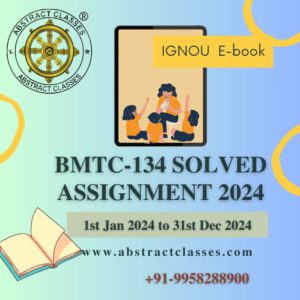
IGNOU BMTC-134 Solved Assignment 2024 | B.Sc (G) CBCS
₹101.00Please read the following points before ordering this IGNOU Assignment Solution.
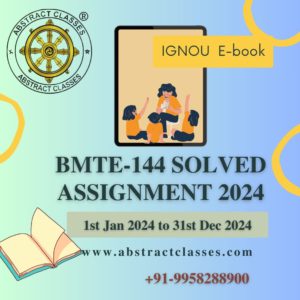
IGNOU BMTE-144 Solved Assignment 2024 | B.Sc (G) CBCS
₹101.00Please read the following points before ordering this IGNOU Assignment Solution.

IGNOU BMTE-141 Solved Assignment 2024 | B.Sc (G) CBCS
₹101.00Please read the following points before ordering this IGNOU Assignment Solution.

IGNOU MSTE-004 Solved Assignment 2024 | PGDAST
₹351.00Access via our Android App Only
Please read the following points before ordering :

IGNOU MSTE-003 Solved Assignment 2024 | PGDAST
₹351.00Access via our Android App Only
Please read the following points before ordering :
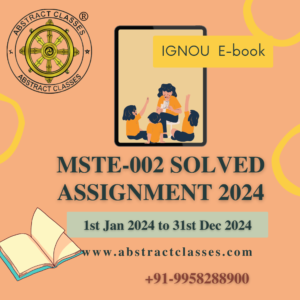
IGNOU MSTE-002 Solved Assignment 2024 | PGDAST
₹351.00Access via our Android App Only
Please read the following points before ordering :
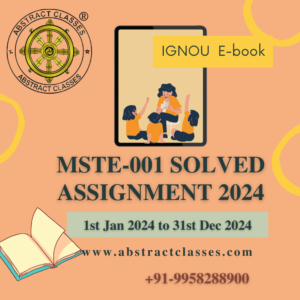
IGNOU MSTE-001 Solved Assignment 2024 | PGDAST
₹351.00Access via our Android App Only
Please read the following points before ordering :

IGNOU MST-005 Solved Assignment 2024 | PGDAST
₹351.00Access via our Android App Only
Please read the following points before ordering :

IGNOU MST-004 Solved Assignment 2024 | PGDAST
₹351.00Access via our Android App Only
Please read the following points before ordering :

IGNOU MST-003 Solved Assignment 2024 | PGDAST
₹351.00Access via our Android App Only
Please read the following points before ordering :

IGNOU MST-002 Solved Assignment 2024 | PGDAST
₹351.00Access via our Android App Only
Please read the following points before ordering :

IGNOU MST-001 Solved Assignment 2024 | PGDAST
₹351.00Access via our Android App Only
Please read the following points before ordering :

IGNOU MST-003 Previous Year Paper Solution | PGDAST
₹365.00Solved Papers – June 2015 to Dec 2023 (Total 18 Papers)
Access via our Android App or any Web browser.
Please read the following points before ordering :

IGNOU MST-005 Previous Year Paper Solution | PGDAST
₹365.00Solved Papers – Dec 2015 to Dec 2023 (Total 17 Papers)
Access via our Android App or any Web browser.
Please read the following points before ordering :
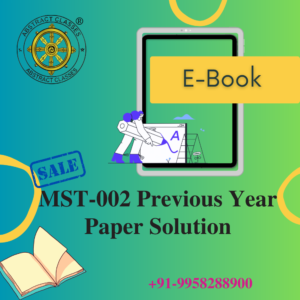
IGNOU MST-002 Previous Year Paper Solution | PGDAST
₹365.00Solved Papers – June 2015 to Dec 2023 (Total 18 Papers)
Access via our Android App or any Web browser.
Please read the following points before ordering :

IGNOU MMTE-001 Solved Assignment 2023 | M.Sc. MACS
₹365.00Access via our Android App Only
Please read the following points before ordering :

UPSC Previous Years Maths Optional Papers with Solution | Paper-02
₹1,095.00Available on our Android App as well.
Please read the following points before ordering :
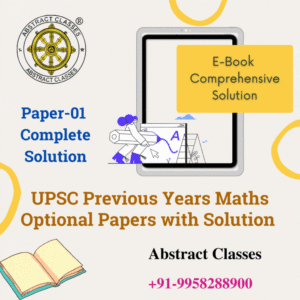
UPSC Previous Years Maths Optional Papers with Solution | Paper-01
₹1,095.00Available on our Android App as well.
Please read the following points before ordering :

IGNOU MST-015 Solved Assignment 2023 | MSCAST
₹365.00Access via our Android App Only
Please read the following points before ordering :

IGNOU MST-014 Solved Assignment 2023 | MSCAST
₹365.00Access via our Android App Only
Please read the following points before ordering :

IGNOU MST-013 Solved Assignment 2023 | MSCAST
₹365.00Access via our Android App Only
Please read the following points before ordering :

IGNOU MST-012 Solved Assignment 2023 | MSCAST
₹365.00Access via our Android App Only
Please read the following points before ordering :

IGNOU MST-011 Solved Assignment 2023 | MSCAST
₹365.00Access via our Android App Only
Please read the following points before ordering :

IGNOU MMT-008 Solved Assignment 2023 | M.Sc. MACS
₹365.00Access via our Android App Only
Please read the following points before ordering :
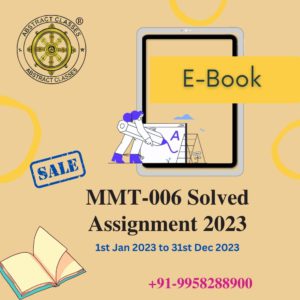
IGNOU MMT-006 Solved Assignment 2023 | M.Sc. MACS
₹365.00Access via our Android App Only
Please read the following points before ordering :
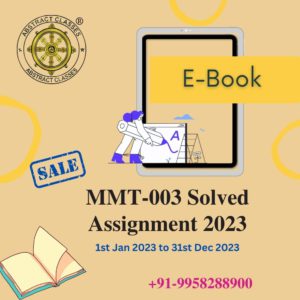
IGNOU MMT-003 Solved Assignment 2023 | M.Sc. MACS
₹365.00Access via our Android App Only
Please read the following points before ordering :
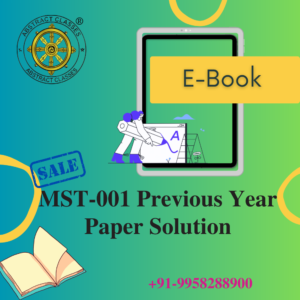
IGNOU MST-001 Previous Year Paper Solution | PGDAST
₹365.00Solved Papers – June 2015 to Dec 2023 (Total 18 Papers)
Access via our Android App or any Web browser.
Please read the following points before ordering :

IGNOU MEV-019 Solved Assignment 2023-2024 | MSCENV
₹101.00Access via our Android App Only
Please read the following points before ordering :

IGNOU MEV-018 Solved Assignment 2023-2024 | MSCENV
₹101.00Access via our Android App Only
Please read the following points before ordering :
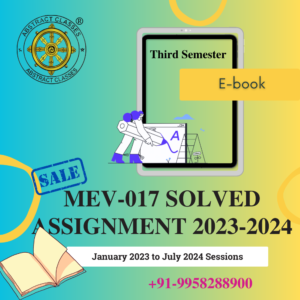
IGNOU MEV-017 Solved Assignment 2023-2024 | MSCENV
₹101.00Access via our Android App Only
Please read the following points before ordering :

IGNOU MEV-016 Solved Assignment 2023-2024 | MSCENV
₹101.00Access via our Android App Only
Please read the following points before ordering :
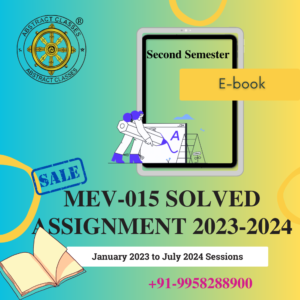
IGNOU MEV-015 Solved Assignment 2023-2024 | MSCENV
₹101.00Access via our Android App Only
Please read the following points before ordering :

IGNOU MEV-014 Solved Assignment 2023-2024 | MSCENV
₹101.00Access via our Android App Only
Please read the following points before ordering :
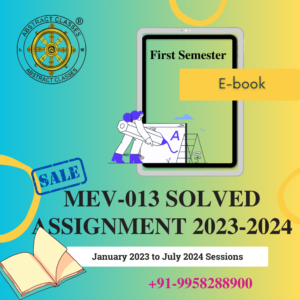
IGNOU MEV-013 Solved Assignment 2023-2024 | MSCENV
₹101.00Access via our Android App Only
Please read the following points before ordering :

IGNOU MEV-012 Solved Assignment 2023-2024 | MSCENV
₹101.00Access via our Android App Only
Please read the following points before ordering :

IGNOU MEV-011 Solved Assignment 2023-2024 | MSCENV
₹101.00Access via our Android App Only
Please read the following points before ordering :

IGNOU BCHET-149 Solved Assignment 2023 | B.Sc (G) CBCS
₹101.00Please read the following points before ordering this IGNOU Assignment Solution.
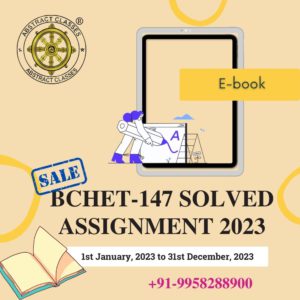
IGNOU BCHET-147 Solved Assignment 2023 | B.Sc (G) CBCS
₹101.00Please read the following points before ordering this IGNOU Assignment Solution.
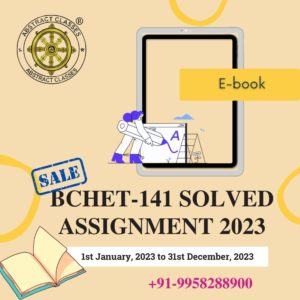
IGNOU BCHET-141 Solved Assignment 2023 | B.Sc (G) CBCS
₹101.00Please read the following points before ordering this IGNOU Assignment Solution.
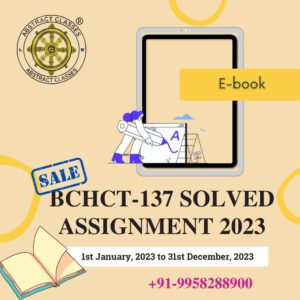
IGNOU BCHCT-137 Solved Assignment 2023 | B.Sc (G) CBCS
₹101.00Please read the following points before ordering this IGNOU Assignment Solution.
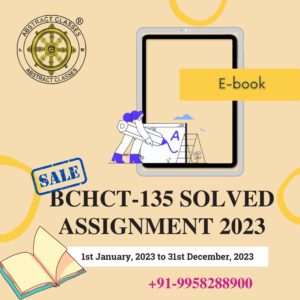
IGNOU BCHCT-135 Solved Assignment 2023 | B.Sc (G) CBCS
₹101.00Please read the following points before ordering this IGNOU Assignment Solution.
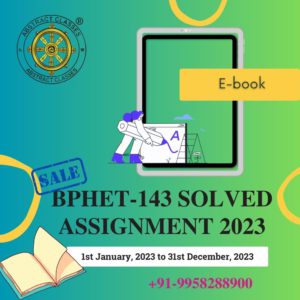
IGNOU BPHET-143 Solved Assignment 2023 | B.Sc. CBCS
₹101.00Access via our Android App Only
Please read the following points before ordering :
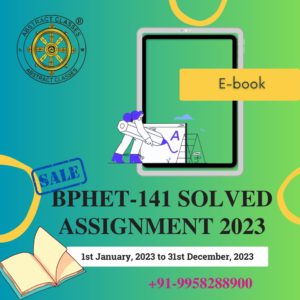
IGNOU BPHET-141 Solved Assignment 2023 | B.Sc. CBCS
₹101.00Access via our Android App Only
Please read the following points before ordering :
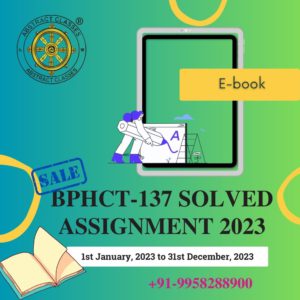
IGNOU BPHCT-137 Solved Assignment 2023 | B.Sc. CBCS
₹101.00Access via our Android App Only
Please read the following points before ordering :
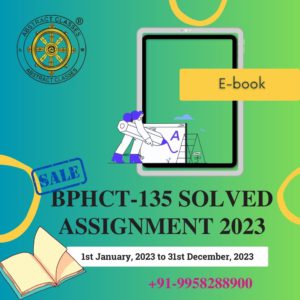
IGNOU BPHCT-135 Solved Assignment 2023 | B.Sc. CBCS
₹101.00Access via our Android App Only
Please read the following points before ordering :
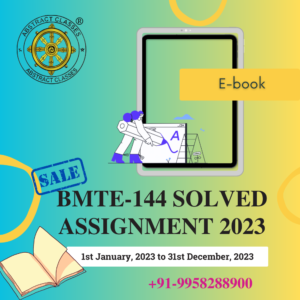
IGNOU BMTE-144 Solved Assignment 2023 | B.Sc (G) CBCS
₹101.00Please read the following points before ordering this IGNOU Assignment Solution.

IGNOU MEG-19 Solved Assignment 2023-2024 | MA MEG
₹101.00Access via our Android App Only
Please read the following points before ordering :

IGNOU MEG-18 Solved Assignment 2023-2024 | MA MEG
₹101.00Access via our Android App Only
Please read the following points before ordering :

IGNOU MEG-17 Solved Assignment 2023-2024 | MA MEG
₹101.00Access via our Android App Only
Please read the following points before ordering :

IGNOU MEG-16 Solved Assignment 2023-2024 | MA MEG
₹101.00Access via our Android App Only
Please read the following points before ordering :

IGNOU MEG-15 Solved Assignment 2023-2024 | MA MEG
₹101.00Access via our Android App Only
Please read the following points before ordering :

IGNOU MEG-14 Solved Assignment 2023-2024 | MA MEG
₹101.00Access via our Android App Only
Please read the following points before ordering :

IGNOU MEG-13 Solved Assignment 2023-2024 | MA MEG
₹101.00Access via our Android App Only
Please read the following points before ordering :

IGNOU MEG-12 Solved Assignment 2023-2024 | MA MEG
₹101.00Access via our Android App Only
Please read the following points before ordering :

IGNOU MEG-11 Solved Assignment 2023-2024 | MA MEG
₹101.00Access via our Android App Only
Please read the following points before ordering :

IGNOU MEG-10 Solved Assignment 2023-2024 | MA MEG
₹101.00Access via our Android App Only
Please read the following points before ordering :

IGNOU MEG-09 Solved Assignment 2023-2024 | MA MEG
₹101.00Access via our Android App Only
Please read the following points before ordering :

IGNOU MEG-08 Solved Assignment 2023-2024 | MA MEG
₹101.00Access via our Android App Only
Please read the following points before ordering :

IGNOU MEG-07 Solved Assignment 2023-2024 | MA MEG
₹101.00Access via our Android App Only
Please read the following points before ordering :

IGNOU MEG-06 Solved Assignment 2023-2024 | MA MEG
₹101.00Access via our Android App Only
Please read the following points before ordering :

IGNOU MEG-05 Solved Assignment 2023-2024 | MA MEG
₹101.00Access via our Android App Only
Please read the following points before ordering :

IGNOU MEG-04 Solved Assignment 2023-2024 | MA MEG
₹101.00Access via our Android App Only
Please read the following points before ordering :

IGNOU MEG-03 Solved Assignment 2023-2024 | MA MEG
₹101.00Access via our Android App Only
Please read the following points before ordering :

IGNOU MEG-02 Solved Assignment 2023-2024 | MA MEG
₹101.00Access via our Android App Only
Please read the following points before ordering :

IGNOU MEG-01 Solved Assignment 2023-2024 | MA MEG
₹101.00Access via our Android App Only
Please read the following points before ordering :
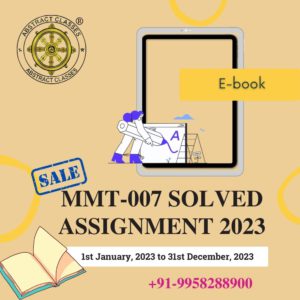
IGNOU MMT-007 Solved Assignment 2023 | M.Sc. MACS
₹351.00Access via our Android App Only
Please read the following points before ordering :

IGNOU MMT-005 Solved Assignment 2023 | M.Sc. MACS
₹351.00Access via our Android App Only
Please read the following points before ordering :

IGNOU MMT-004 Solved Assignment 2023 | M.Sc. MACS
₹351.00Access via our Android App Only
Please read the following points before ordering :
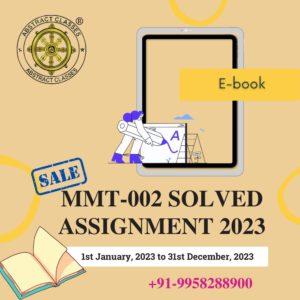
IGNOU MMT-002 Solved Assignment 2023 | M.Sc. MACS
₹351.00Access via our Android App Only
Please read the following points before ordering :
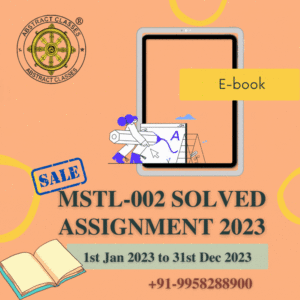
IGNOU MSTL-002 Solved Assignment 2023 | PGDAST
₹401.00Access via our Android App Only
Please read the following points before ordering :
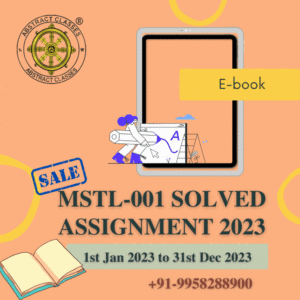
IGNOU MSTL-001 Solved Assignment 2023 | PGDAST
₹401.00Access via our Android App Only
Please read the following points before ordering :

IGNOU PHE-06 Solved Assignment 2023
₹201.00Please read the following points before ordering this IGNOU Assignment Solution.
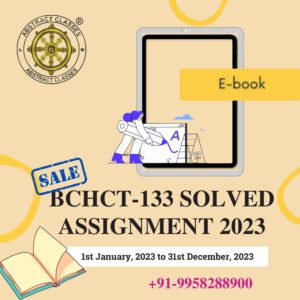
IGNOU BCHCT-133 Solved Assignment 2023 | B.Sc (G) CBCS
₹101.00Please read the following points before ordering this IGNOU Assignment Solution.

IGNOU BCHCT-131 Solved Assignment 2023 | B.Sc (G) CBCS
₹101.00Please read the following points before ordering this IGNOU Assignment Solution.
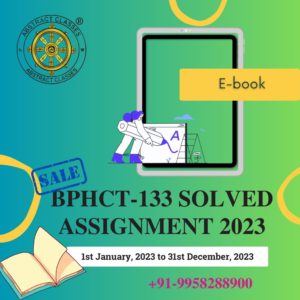
IGNOU BPHCT-133 Solved Assignment 2023 | B.Sc (G) CBCS
₹101.00Please read the following points before ordering this IGNOU Assignment Solution.

IGNOU BPHCT-131 Solved Assignment 2023 | B.Sc (G) CBCS
₹101.00Please read the following points before ordering this IGNOU Assignment Solution.

IGNOU BMTE-141 Solved Assignment 2023 | B.Sc (G) CBCS
₹101.00Please read the following points before ordering this IGNOU Assignment Solution.
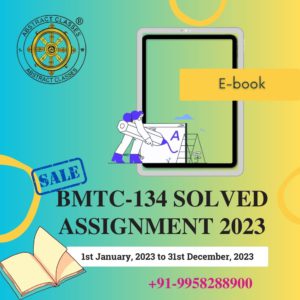
IGNOU BMTC-134 Solved Assignment 2023 | B.Sc (G) CBCS
₹101.00Please read the following points before ordering this IGNOU Assignment Solution.
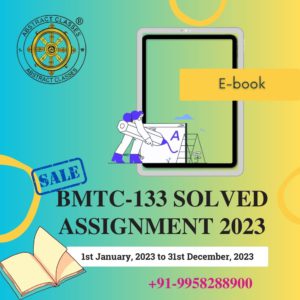
IGNOU BMTC-133 Solved Assignment 2023 | B.Sc (G) CBCS
₹101.00Please read the following points before ordering this IGNOU Assignment Solution.
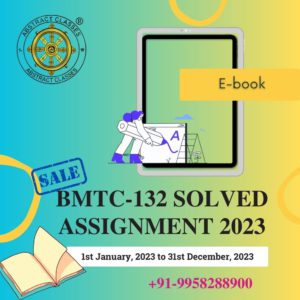
IGNOU BMTC-132 Solved Assignment 2023 | B.Sc (G) CBCS
₹101.00Please read the following points before ordering this IGNOU Assignment Solution.
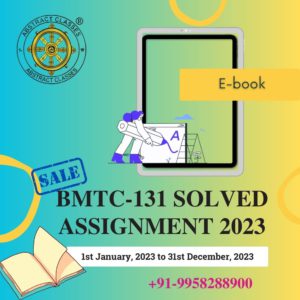
IGNOU BMTC-131 Solved Assignment 2023 | B.Sc (G) CBCS
₹101.00Please read the following points before ordering this IGNOU Assignment Solution.
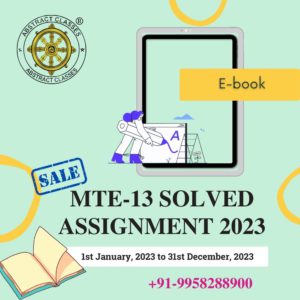
IGNOU MTE-13 Solved Assignment 2023 | MTE
₹251.00Please read the following points before ordering this IGNOU Assignment Solution.
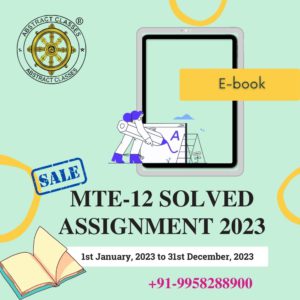
IGNOU MTE-12 Solved Assignment 2023 | MTE
₹251.00Please read the following points before ordering this IGNOU Assignment Solution.

IGNOU MTE-11 Solved Assignment 2023 | MTE
₹251.00Please read the following points before ordering this IGNOU Assignment Solution.
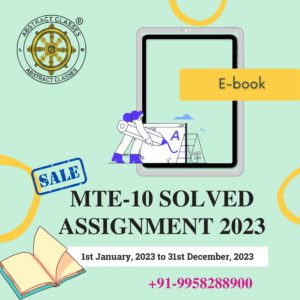
IGNOU MTE-10 Solved Assignment 2023 | MTE
₹201.00Please read the following points before ordering this IGNOU Assignment Solution.
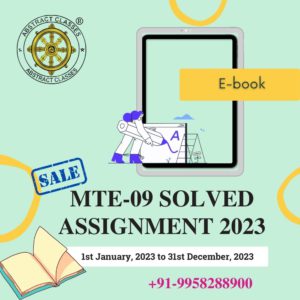
IGNOU MTE-09 Solved Assignment 2023 | MTE
₹201.00Please read the following points before ordering this IGNOU Assignment Solution.
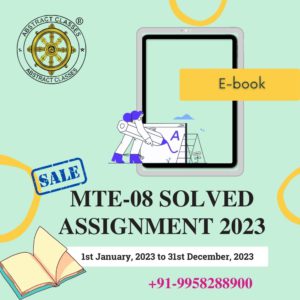
IGNOU MTE-08 Solved Assignment 2023 | MTE
₹201.00Please read the following points before ordering this IGNOU Assignment Solution.
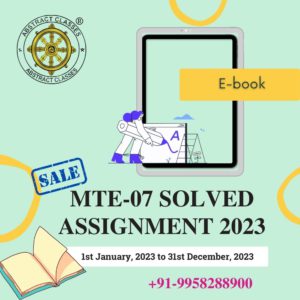
IGNOU MTE-07 Solved Assignment 2023 | MTE
₹201.00Please read the following points before ordering this IGNOU Assignment Solution.

IGNOU MTE-06 Solved Assignment 2023 | MTE
₹151.00Please read the following points before ordering this IGNOU Assignment Solution.
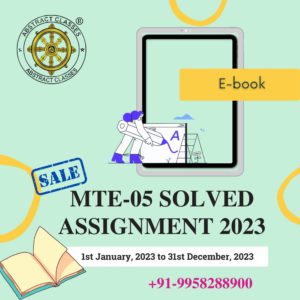
IGNOU MTE-05 Solved Assignment 2023 | MTE
₹151.00Please read the following points before ordering this IGNOU Assignment Solution.
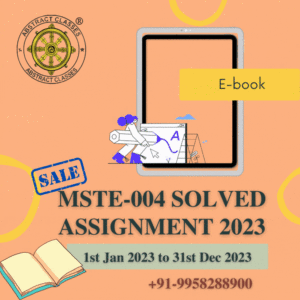
IGNOU MSTE-004 Solved Assignment 2023 | PGDAST
₹351.00Access via our Android App Only
Please read the following points before ordering :
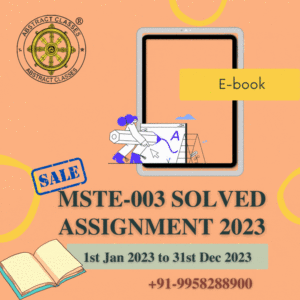
IGNOU MSTE-003 Solved Assignment 2023 | PGDAST
₹351.00Access via our Android App Only
Please read the following points before ordering :
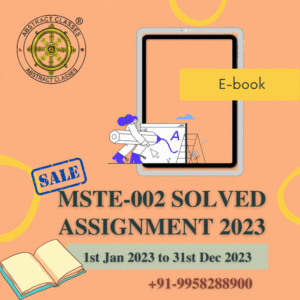
IGNOU MSTE-002 Solved Assignment 2023 | PGDAST
₹351.00Access via our Android App Only
Please read the following points before ordering :

IGNOU MMT-001 Solved Assignment 2023 | MA MACS
₹351.00Access via our Android App Only
Please read the following points before ordering :

IGNOU MSTE-001 Solved Assignment 2023 | PGDAST
₹351.00Access via our Android App Only
Please read the following points before ordering :

IGNOU MST-005 Solved Assignment 2023 | PGDAST
₹351.00Access via our Android App Only
Please read the following points before ordering :

IGNOU BEVAE-181 Solved Assignment 2022-2023 | BSCG/ BAG/ BCOMG | AECC ON ENVIRONMENTAL STUDIES
₹51.00Please read the following points before ordering this IGNOU Assignment Solution.

IGNOU BEGC-133 Assignment Solution 2022-2023 | BAG | BRITISH LITERATURE
₹51.00Please read the following points before ordering this IGNOU Assignment Solution.

IGNOU BEGC-134 Assignment Solution 2022-2023 | BAG | Reading the Novel
₹51.00Please read the following points before ordering this IGNOU Assignment Solution.

IGNOU BEGLA-137 Assignment Solution 2022-2023 | BAG | Language through Literature
₹51.00Please read the following points before ordering this IGNOU Assignment Solution.

IGNOU BEGLA-138 Assignment Solution 2022-2023 | BAG | Reading & Speaking Skills
₹51.00Please read the following points before ordering this IGNOU Assignment Solution.

IGNOU BEGS-183 Assignment Solution 2022-2023 | BAG | WRITING AND STUDY SKILLS
₹51.00Please read the following points before ordering this IGNOU Assignment Solution.

IGNOU BSOC – 133 Solved Assignment 2022-2023 | BAG | SOCIOLOGICAL THEORIES
₹51.00Please read the following points before ordering this IGNOU Assignment Solution.

IGNOU BSOC – 134 Solved Assignment 2022-2023 | B.A.G | METHODS OF SOCIOLOGICAL ENQUIRY
₹51.00Please read the following points before ordering this IGNOU Assignment Solution.

IGNOU BCOS – 184 Solved Assignment 2022-2023 | B.Com | E-COMMERCE
₹51.00Please read the following points before ordering this IGNOU Assignment Solution.
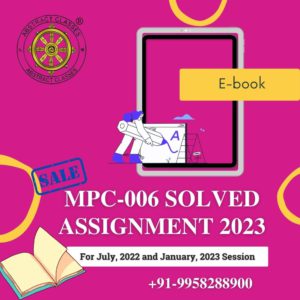
IGNOU MPC-006 Solved Assignment 2022-2023 | MAPC | STATISTICS IN PSYCHOLOGY
₹101.00Please read the following points before ordering this IGNOU Assignment Solution.

IGNOU MPC-005 Solved Assignment 2022-2023 | MAPC | Research Methods
₹101.00Please read the following points before ordering this IGNOU Assignment Solution.
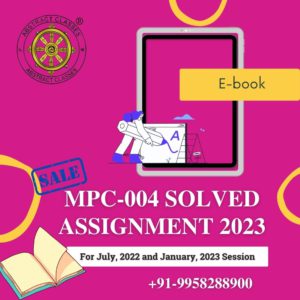
IGNOU MPC-004 Solved Assignment 2022-2023 | MAPC | ADVANCED SOCIAL PSYCHOLOGY
₹101.00Please read the following points before ordering this IGNOU Assignment Solution.
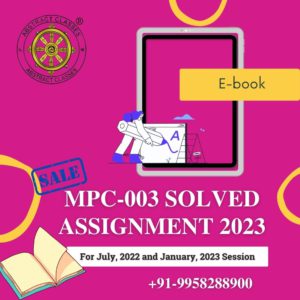
IGNOU MPC-003 Solved Assignment 2022-2023 | MAPC | PERSONALITY: THEORIES AND ASSESSMENT
₹101.00Please read the following points before ordering this IGNOU Assignment Solution.

IGNOU MPC-002 Solved Assignment 2022-2023 | MAPC | LIFE SPAN PSYCHOLOGY
₹101.00Please read the following points before ordering this IGNOU Assignment Solution.
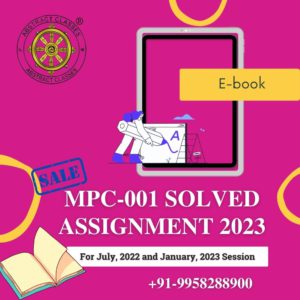
IGNOU MPC-001 Solved Assignment 2022-2023 | MAPC | Cognitive Psychology, Learning and Memory
₹101.00Please read the following points before ordering this IGNOU Assignment Solution.

IGNOU MEG-19 Solved Assignment 2022-2023 | MEG | THE AUSTRALIAN NOVEL
₹101.00Please read the following points before ordering this IGNOU Assignment Solution.

IGNOU MEG-18 Solved Assignment 2022-2023 | MEG | American Poetry
₹101.00Please read the following points before ordering this IGNOU Assignment Solution.

IGNOU MEG-17 Solved Assignment 2022-2023 | MEG | American Drama
₹101.00Please read the following points before ordering this IGNOU Assignment Solution.

IGNOU MEG-16 Solved Assignment 2022-2023 | MEG | Indian Folk Literature
₹101.00Please read the following points before ordering this IGNOU Assignment Solution.

IGNOU MEG-15 Solved Assignment 2022-2023 | MEG | Comparative Literature: Theory and Practice
₹101.00Please read the following points before ordering this IGNOU Assignment Solution.

IGNOU MEG-14 Solved Assignment 2022-2023 | MEG | Contemporary Indian Literature in English Translation
₹101.00Please read the following points before ordering this IGNOU Assignment Solution.

IGNOU MEG-13 Solved Assignment 2022-2023 | MEG | WRITINGS FROM THE MARGINS
₹101.00Please read the following points before ordering this IGNOU Assignment Solution.

IGNOU MEG-12 Solved Assignment 2022-2023 | MEG | A Survey Course in 20th Century Canadian Literature
₹101.00Please read the following points before ordering this IGNOU Assignment Solution.

IGNOU MEG-11 Solved Assignment 2022-2023 | MEG | AMERICAN NOVEL
₹101.00Please read the following points before ordering this IGNOU Assignment Solution.

IGNOU MEG-10 Solved Assignment 2022-2023 | MEG | ENGLISH STUDIES IN INDIA
₹101.00Please read the following points before ordering this IGNOU Assignment Solution.

IGNOU MEG-09 Solved Assignment 2022-2023 | MEG | Australian Literature
₹101.00Please read the following points before ordering this IGNOU Assignment Solution.

IGNOU MEG-08 Solved Assignment 2022-2023 | MEG | NEW LITERATURES IN ENGLISH
₹101.00Please read the following points before ordering this IGNOU Assignment Solution.

IGNOU MEG-07 Solved Assignment 2022-2023 | MEG | INDIAN ENGLISH LITERATURE
₹101.00Please read the following points before ordering this IGNOU Assignment Solution.

IGNOU MEG-06 Solved Assignment 2022-2023 | MEG | AMERICAN LITERATURE
₹101.00Please read the following points before ordering this IGNOU Assignment Solution.

IGNOU MEG-05 Solved Assignment 2022-2023 | MEG | LITERARY CRITICISM & THEORY
₹101.00Please read the following points before ordering this IGNOU Assignment Solution.

IGNOU MEG-04 Solved Assignment 2022-2023 | MEG | ASPECTS OF LANGUAGE
₹101.00Please read the following points before ordering this IGNOU Assignment Solution.

IGNOU MEG-03 Solved Assignment 2022-2023 | MEG | British Novel
₹101.00Please read the following points before ordering this IGNOU Assignment Solution.

IGNOU MEG-02 Solved Assignment 2022-2023 | MEG | British Drama
₹101.00Please read the following points before ordering this IGNOU Assignment Solution.

IGNOU MEG-01 Solved Assignment 2022-2023 | MEG | British Poetry
₹101.00Please read the following points before ordering this IGNOU Assignment Solution.
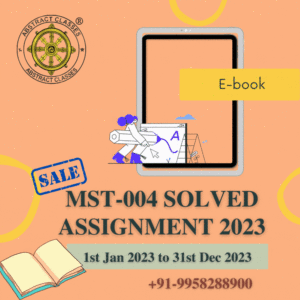
IGNOU MST-004 Solved Assignment 2023 | PGDAST
₹351.00Access via our Android App Only
Please read the following points before ordering :

IGNOU MST-003 Solved Assignment 2023 | PGDAST
₹351.00Access via our Android App Only
Please read the following points before ordering :

IGNOU MST-002 Solved Assignment 2023 | PGDAST
₹351.00Access via our Android App Only
Please read the following points before ordering :

IGNOU MST-001 Solved Assignment 2023 | PGDAST
₹351.00Access via our Android App Only
Please read the following points before ordering :

Stop and Take a Second
₹110.00Donec pede justo, fringilla vel, aliquet nec, vulputate eget, arcu. In enim justo, rhoncus ut, imperdiet a, venenatis vitae, justo.
There are many variations of passages of Lorem Ipsum available, but the majority have suffered alteration in some form, by injected humour, or randomised words which don’t look even slightly.

Running From Me
₹70.00Donec pede justo, fringilla vel, aliquet nec, vulputate eget, arcu. In enim justo, rhoncus ut, imperdiet a, venenatis vitae, justo.
There are many variations of passages of Lorem Ipsum available, but the majority have suffered alteration in some form, by injected humour, or randomised words which don’t look even slightly.

Red Side Book
₹300.00Donec pede justo, fringilla vel, aliquet nec, vulputate eget, arcu. In enim justo, rhoncus ut, imperdiet a, venenatis vitae, justo.
There are many variations of passages of Lorem Ipsum available, but the majority have suffered alteration in some form, by injected humour, or randomised words which don’t look even slightly.

Real Life Fairytale
₹250.00Donec pede justo, fringilla vel, aliquet nec, vulputate eget, arcu. In enim justo, rhoncus ut, imperdiet a, venenatis vitae, justo.
There are many variations of passages of Lorem Ipsum available, but the majority have suffered alteration in some form, by injected humour, or randomised words which don’t look even slightly.

Note Book Mockup
₹200.00Donec pede justo, fringilla vel, aliquet nec, vulputate eget, arcu. In enim justo, rhoncus ut, imperdiet a, venenatis vitae, justo.
There are many variations of passages of Lorem Ipsum available, but the majority have suffered alteration in some form, by injected humour, or randomised words which don’t look even slightly.

Motivational Book Cover
This story, dazzling in its powerful simplicity and soul-stirring wisdom, is about an Andalusian shepherd boy named Santiago who travels from his homeland in Spain to the Egyptian desert in search of a treasure buried near the Pyramids. Lorem ipsum dolor sit amet, consectetur adipiscing elit, sed do eiusmod tempor incididunt ut labore et. Lorem ipsum dolor sit amet, consectetur adipiscing elit, sed do eiusmod tempor incididunt etc.
1 in stock

Book Cover Softcover
This story, dazzling in its powerful simplicity and soul-stirring wisdom, is about an Andalusian shepherd boy named Santiago who travels from his homeland in Spain to the Egyptian desert in search of a treasure buried near the Pyramids. Lorem ipsum dolor sit amet, consectetur adipiscing elit, sed do eiusmod tempor incididunt ut labore et. Lorem ipsum dolor sit amet, consectetur adipiscing elit, sed do eiusmod tempor incididunt etc.
4 in stock

IGNOU MSTE-004 Previous Year Paper Solution | PGDAST
₹365.00Solved Papers – Dec 2022 to Dec 2023 (Total 3 Papers)
Access via our Android App or any Web browser.
Please read the following points before ordering :

IGNOU MSTE-003 Previous Year Paper Solution | PGDAST
₹365.00Solved Papers – Dec 2022 to Dec 2023 (Total 3 Papers)
Access via our Android App or any Web browser.
Please read the following points before ordering :

IGNOU MSTE-002 Previous Year Paper Solution | PGDAST
₹365.00Solved Papers – June 2015 to Dec 2023 (Total 18 Papers)
Access via our Android App or any Web browser.
Please read the following points before ordering :

IGNOU MSTE-001 Previous Year Paper Solution | PGDAST
₹365.00Solved Papers – Dec 2015 to Dec 2023 (Total 17 Papers)
Access via our Android App or any Web browser.
Please read the following points before ordering :

IGNOU MST-004 Previous Year Paper Solution | PGDAST
₹365.00Solved Papers – June 2015 to Dec 2023 (Total 18 Papers)
Access via our Android App or any Web browser.
Please read the following points before ordering :

IGNOU MST-019 Solved Assignment 2024 | MSCAST | IGNOU
₹365.00Access via our Android App Only
Please read the following points before ordering :

IGNOU MST-018 Solved Assignment 2024 | MSCAST | IGNOU
₹365.00Access via our Android App Only
Please read the following points before ordering :

IGNOU MST-017 Solved Assignment 2024 | MSCAST | IGNOU
₹365.00Access via our Android App Only
Please read the following points before ordering :

IGNOU MST-016 Solved Assignment 2024 | MSCAST | IGNOU
₹365.00Access via our Android App Only
Please read the following points before ordering :

IGNOU MPH-005 Solved Assignment 2024 | MSCPH | IGNOU
₹365.00Access via our Android App Only
Please read the following points before ordering :

IGNOU MPH-004 Solved Assignment 2024 | MSCPH | IGNOU
₹365.00Access via our Android App Only
Please read the following points before ordering :

IGNOU MPH-003 Solved Assignment 2024 | MSCPH | IGNOU
₹365.00Access via our Android App Only
Please read the following points before ordering :

IGNOU MPH-002 Solved Assignment 2024 | MSCPH | IGNOU
₹365.00Access via our Android App Only
Please read the following points before ordering :

IGNOU MPH-001 Solved Assignment 2024 | MSCPH | IGNOU
₹365.00Access via our Android App Only
Please read the following points before ordering :

IGNOU BZYET-143 Solved Assignment 2024 | B.Sc. CBCS Zoology
₹49.00Please read the following points before ordering this IGNOU Assignment Solution.

IGNOU BZYET-141 Solved Assignment 2024 | B.Sc. CBCS Zoology
₹49.00Please read the following points before ordering this IGNOU Assignment Solution.

IGNOU BZYCT-137 Solved Assignment 2024 | B.Sc. CBCS Zoology
₹49.00Please read the following points before ordering this IGNOU Assignment Solution.

IGNOU BZYCT-135 Solved Assignment 2024 | B.Sc. CBCS Zoology
₹49.00Please read the following points before ordering this IGNOU Assignment Solution.

IGNOU MMT-007 Solved Assignment 2024 | M.Sc. MACS
₹365.00Access via our Android App Only
Please read the following points before ordering :

IGNOU MMT-005 Solved Assignment 2024 | M.Sc. MACS
₹365.00Access via our Android App Only
Please read the following points before ordering :

IGNOU MMT-004 Solved Assignment 2024 | M.Sc. MACS
₹365.00Access via our Android App Only
Please read the following points before ordering :

IGNOU MMT-002 Solved Assignment 2024 | M.Sc. MACS
₹365.00Access via our Android App Only
Please read the following points before ordering :

IGNOU MMT-001 Solved Assignment 2024 | M.Sc. MACS
₹365.00Access via our Android App Only
Please read the following points before ordering :

IGNOU MMT-008 Solved Assignment 2024 | M.Sc. MACS
₹365.00Access via our Android App Only
Please read the following points before ordering :

IGNOU MMTE-001 Solved Assignment 2024 | M.Sc. MACS
₹365.00Access via our Android App Only
Please read the following points before ordering :

IGNOU MMTE-002 Solved Assignment 2024 | M.Sc. MACS
₹365.00Access via our Android App Only
Please read the following points before ordering :

IGNOU MMT-009 Solved Assignment 2024 | M.Sc. MACS
₹365.00Access via our Android App Only
Please read the following points before ordering :

IGNOU MMTE-004 Solved Assignment 2024 | M.Sc. MACS
₹365.00Access via our Android App Only
Please read the following points before ordering :

IGNOU MMTE-003 Solved Assignment 2024 | M.Sc. MACS
₹365.00Access via our Android App Only
Please read the following points before ordering :

IGNOU MMT-006 Solved Assignment 2024 | M.Sc. MACS
₹365.00Access via our Android App Only
Please read the following points before ordering :

IGNOU MMT-003 Solved Assignment 2024 | M.Sc. MACS
₹365.00Access via our Android App Only
Please read the following points before ordering :

IGNOU BCHET-147 Solved Assignment 2024 | B.Sc. CBCS Chemistry
₹49.00Please read the following points before ordering this IGNOU Assignment Solution.

IGNOU BCHET-141 Solved Assignment 2024 | B.Sc. CBCS Chemistry
₹49.00Please read the following points before ordering this IGNOU Assignment Solution.

IGNOU BCHCT-137 Solved Assignment 2024 | B.Sc. CBCS Chemistry
₹49.00Please read the following points before ordering this IGNOU Assignment Solution.

IGNOU BCHCT-135 Solved Assignment 2024 | B.Sc. CBCS Chemistry
₹49.00Please read the following points before ordering this IGNOU Assignment Solution.

IGNOU BPHET-143 Solved Assignment 2024 | B.Sc (G) CBCS
₹101.00Please read the following points before ordering this IGNOU Assignment Solution.

IGNOU BPHET-141 Solved Assignment 2024 | B.Sc (G) CBCS
₹101.00Please read the following points before ordering this IGNOU Assignment Solution.

IGNOU BPHCT-137 Solved Assignment 2024 | B.Sc (G) CBCS
₹101.00Please read the following points before ordering this IGNOU Assignment Solution.

IGNOU BPHCT-135 Solved Assignment 2024 | B.Sc (G) CBCS
₹101.00Please read the following points before ordering this IGNOU Assignment Solution.

IGNOU BPHCT-133 Solved Assignment 2024 | B.Sc (G) CBCS
₹101.00Please read the following points before ordering this IGNOU Assignment Solution.

IGNOU BPHCT-131 Solved Assignment 2024 | B.Sc (G) CBCS
₹101.00Please read the following points before ordering this IGNOU Assignment Solution.

IGNOU BBYET-143 Solved Assignment 2024 | B.Sc. CBCS Botany
₹49.00Please read the following points before ordering this IGNOU Assignment Solution.

IGNOU BBYET-141 Solved Assignment 2024 | B.Sc. CBCS Botany
₹49.00Please read the following points before ordering this IGNOU Assignment Solution.

IGNOU BBYCT-137 Solved Assignment 2024 | B.Sc. CBCS Botany
₹49.00Please read the following points before ordering this IGNOU Assignment Solution.

IGNOU BBYCT-135 Solved Assignment 2024 | B.Sc. CBCS Botany
₹49.00Please read the following points before ordering this IGNOU Assignment Solution.

IGNOU BBYCT-133 Solved Assignment 2024 | B.Sc. CBCS Botany
₹49.00Please read the following points before ordering this IGNOU Assignment Solution.

IGNOU BBYCT-131 Solved Assignment 2024 | B.Sc. CBCS Botany
₹49.00Please read the following points before ordering this IGNOU Assignment Solution.

IGNOU BZYCT-133 Solved Assignment 2024 | B.Sc. CBCS Zoology
₹49.00Please read the following points before ordering this IGNOU Assignment Solution.

IGNOU BZYCT-131 Solved Assignment 2024 | B.Sc. CBCS Zoology
₹49.00Please read the following points before ordering this IGNOU Assignment Solution.

IGNOU BCHCT-133 Solved Assignment 2024 | B.Sc. CBCS Chemistry
₹49.00Please read the following points before ordering this IGNOU Assignment Solution.

IGNOU BCHCT-131 Solved Assignment 2024 | B.Sc. CBCS Chemistry
₹49.00Please read the following points before ordering this IGNOU Assignment Solution.

IGNOU BEGAE-182 Solved Assignment 2024 | CBCS
₹49.00Please read the following points before ordering this IGNOU Assignment Solution.

IGNOU BEVAE-181 Solved Assignment 2024 | B.Sc (G) CBCS AECC
₹49.00Please read the following points before ordering this IGNOU Assignment Solution.

IGNOU BMTC-132 Solved Assignment 2024 | B.Sc (G) CBCS
₹101.00Please read the following points before ordering this IGNOU Assignment Solution.

IGNOU BMTC-131 Solved Assignment 2024 | B.Sc (G) CBCS
₹101.00Please read the following points before ordering this IGNOU Assignment Solution.

IGNOU BMTC-133 Solved Assignment 2024 | B.Sc (G) CBCS
₹101.00Please read the following points before ordering this IGNOU Assignment Solution.

IGNOU BMTC-134 Solved Assignment 2024 | B.Sc (G) CBCS
₹101.00Please read the following points before ordering this IGNOU Assignment Solution.

IGNOU BMTE-144 Solved Assignment 2024 | B.Sc (G) CBCS
₹101.00Please read the following points before ordering this IGNOU Assignment Solution.

IGNOU BMTE-141 Solved Assignment 2024 | B.Sc (G) CBCS
₹101.00Please read the following points before ordering this IGNOU Assignment Solution.

IGNOU MSTE-004 Solved Assignment 2024 | PGDAST
₹351.00Access via our Android App Only
Please read the following points before ordering :

IGNOU MSTE-003 Solved Assignment 2024 | PGDAST
₹351.00Access via our Android App Only
Please read the following points before ordering :

IGNOU MSTE-002 Solved Assignment 2024 | PGDAST
₹351.00Access via our Android App Only
Please read the following points before ordering :

IGNOU MSTE-001 Solved Assignment 2024 | PGDAST
₹351.00Access via our Android App Only
Please read the following points before ordering :

IGNOU MST-005 Solved Assignment 2024 | PGDAST
₹351.00Access via our Android App Only
Please read the following points before ordering :

IGNOU MST-004 Solved Assignment 2024 | PGDAST
₹351.00Access via our Android App Only
Please read the following points before ordering :

IGNOU MST-003 Solved Assignment 2024 | PGDAST
₹351.00Access via our Android App Only
Please read the following points before ordering :

IGNOU MST-002 Solved Assignment 2024 | PGDAST
₹351.00Access via our Android App Only
Please read the following points before ordering :

IGNOU MST-001 Solved Assignment 2024 | PGDAST
₹351.00Access via our Android App Only
Please read the following points before ordering :

IGNOU MST-003 Previous Year Paper Solution | PGDAST
₹365.00Solved Papers – June 2015 to Dec 2023 (Total 18 Papers)
Access via our Android App or any Web browser.
Please read the following points before ordering :

IGNOU MST-005 Previous Year Paper Solution | PGDAST
₹365.00Solved Papers – Dec 2015 to Dec 2023 (Total 17 Papers)
Access via our Android App or any Web browser.
Please read the following points before ordering :

IGNOU MST-002 Previous Year Paper Solution | PGDAST
₹365.00Solved Papers – June 2015 to Dec 2023 (Total 18 Papers)
Access via our Android App or any Web browser.
Please read the following points before ordering :

IGNOU MMTE-001 Solved Assignment 2023 | M.Sc. MACS
₹365.00Access via our Android App Only
Please read the following points before ordering :

UPSC Previous Years Maths Optional Papers with Solution | Paper-02
₹1,095.00Available on our Android App as well.
Please read the following points before ordering :

UPSC Previous Years Maths Optional Papers with Solution | Paper-01
₹1,095.00Available on our Android App as well.
Please read the following points before ordering :

IGNOU MST-015 Solved Assignment 2023 | MSCAST
₹365.00Access via our Android App Only
Please read the following points before ordering :

IGNOU MST-014 Solved Assignment 2023 | MSCAST
₹365.00Access via our Android App Only
Please read the following points before ordering :

IGNOU MST-013 Solved Assignment 2023 | MSCAST
₹365.00Access via our Android App Only
Please read the following points before ordering :

IGNOU MST-012 Solved Assignment 2023 | MSCAST
₹365.00Access via our Android App Only
Please read the following points before ordering :

IGNOU MST-011 Solved Assignment 2023 | MSCAST
₹365.00Access via our Android App Only
Please read the following points before ordering :

IGNOU MMT-008 Solved Assignment 2023 | M.Sc. MACS
₹365.00Access via our Android App Only
Please read the following points before ordering :

IGNOU MMT-006 Solved Assignment 2023 | M.Sc. MACS
₹365.00Access via our Android App Only
Please read the following points before ordering :

IGNOU MMT-003 Solved Assignment 2023 | M.Sc. MACS
₹365.00Access via our Android App Only
Please read the following points before ordering :

IGNOU MST-001 Previous Year Paper Solution | PGDAST
₹365.00Solved Papers – June 2015 to Dec 2023 (Total 18 Papers)
Access via our Android App or any Web browser.
Please read the following points before ordering :

IGNOU MEV-019 Solved Assignment 2023-2024 | MSCENV
₹101.00Access via our Android App Only
Please read the following points before ordering :

IGNOU MEV-018 Solved Assignment 2023-2024 | MSCENV
₹101.00Access via our Android App Only
Please read the following points before ordering :

IGNOU MEV-017 Solved Assignment 2023-2024 | MSCENV
₹101.00Access via our Android App Only
Please read the following points before ordering :

IGNOU MEV-016 Solved Assignment 2023-2024 | MSCENV
₹101.00Access via our Android App Only
Please read the following points before ordering :

IGNOU MEV-015 Solved Assignment 2023-2024 | MSCENV
₹101.00Access via our Android App Only
Please read the following points before ordering :

IGNOU MEV-014 Solved Assignment 2023-2024 | MSCENV
₹101.00Access via our Android App Only
Please read the following points before ordering :

IGNOU MEV-013 Solved Assignment 2023-2024 | MSCENV
₹101.00Access via our Android App Only
Please read the following points before ordering :

IGNOU MEV-012 Solved Assignment 2023-2024 | MSCENV
₹101.00Access via our Android App Only
Please read the following points before ordering :

IGNOU MEV-011 Solved Assignment 2023-2024 | MSCENV
₹101.00Access via our Android App Only
Please read the following points before ordering :

IGNOU BCHET-149 Solved Assignment 2023 | B.Sc (G) CBCS
₹101.00Please read the following points before ordering this IGNOU Assignment Solution.

IGNOU BCHET-147 Solved Assignment 2023 | B.Sc (G) CBCS
₹101.00Please read the following points before ordering this IGNOU Assignment Solution.

IGNOU BCHET-141 Solved Assignment 2023 | B.Sc (G) CBCS
₹101.00Please read the following points before ordering this IGNOU Assignment Solution.

IGNOU BCHCT-137 Solved Assignment 2023 | B.Sc (G) CBCS
₹101.00Please read the following points before ordering this IGNOU Assignment Solution.

IGNOU BCHCT-135 Solved Assignment 2023 | B.Sc (G) CBCS
₹101.00Please read the following points before ordering this IGNOU Assignment Solution.

IGNOU BPHET-143 Solved Assignment 2023 | B.Sc. CBCS
₹101.00Access via our Android App Only
Please read the following points before ordering :

IGNOU BPHET-141 Solved Assignment 2023 | B.Sc. CBCS
₹101.00Access via our Android App Only
Please read the following points before ordering :

IGNOU BPHCT-137 Solved Assignment 2023 | B.Sc. CBCS
₹101.00Access via our Android App Only
Please read the following points before ordering :

IGNOU BPHCT-135 Solved Assignment 2023 | B.Sc. CBCS
₹101.00Access via our Android App Only
Please read the following points before ordering :

IGNOU BMTE-144 Solved Assignment 2023 | B.Sc (G) CBCS
₹101.00Please read the following points before ordering this IGNOU Assignment Solution.

IGNOU MEG-19 Solved Assignment 2023-2024 | MA MEG
₹101.00Access via our Android App Only
Please read the following points before ordering :

IGNOU MEG-18 Solved Assignment 2023-2024 | MA MEG
₹101.00Access via our Android App Only
Please read the following points before ordering :

IGNOU MEG-17 Solved Assignment 2023-2024 | MA MEG
₹101.00Access via our Android App Only
Please read the following points before ordering :

IGNOU MEG-16 Solved Assignment 2023-2024 | MA MEG
₹101.00Access via our Android App Only
Please read the following points before ordering :

IGNOU MEG-15 Solved Assignment 2023-2024 | MA MEG
₹101.00Access via our Android App Only
Please read the following points before ordering :

IGNOU MEG-14 Solved Assignment 2023-2024 | MA MEG
₹101.00Access via our Android App Only
Please read the following points before ordering :

IGNOU MEG-13 Solved Assignment 2023-2024 | MA MEG
₹101.00Access via our Android App Only
Please read the following points before ordering :

IGNOU MEG-12 Solved Assignment 2023-2024 | MA MEG
₹101.00Access via our Android App Only
Please read the following points before ordering :

IGNOU MEG-11 Solved Assignment 2023-2024 | MA MEG
₹101.00Access via our Android App Only
Please read the following points before ordering :

IGNOU MEG-10 Solved Assignment 2023-2024 | MA MEG
₹101.00Access via our Android App Only
Please read the following points before ordering :

IGNOU MEG-09 Solved Assignment 2023-2024 | MA MEG
₹101.00Access via our Android App Only
Please read the following points before ordering :

IGNOU MEG-08 Solved Assignment 2023-2024 | MA MEG
₹101.00Access via our Android App Only
Please read the following points before ordering :

IGNOU MEG-07 Solved Assignment 2023-2024 | MA MEG
₹101.00Access via our Android App Only
Please read the following points before ordering :

IGNOU MEG-06 Solved Assignment 2023-2024 | MA MEG
₹101.00Access via our Android App Only
Please read the following points before ordering :

IGNOU MEG-05 Solved Assignment 2023-2024 | MA MEG
₹101.00Access via our Android App Only
Please read the following points before ordering :

IGNOU MEG-04 Solved Assignment 2023-2024 | MA MEG
₹101.00Access via our Android App Only
Please read the following points before ordering :

IGNOU MEG-03 Solved Assignment 2023-2024 | MA MEG
₹101.00Access via our Android App Only
Please read the following points before ordering :

IGNOU MEG-02 Solved Assignment 2023-2024 | MA MEG
₹101.00Access via our Android App Only
Please read the following points before ordering :

IGNOU MEG-01 Solved Assignment 2023-2024 | MA MEG
₹101.00Access via our Android App Only
Please read the following points before ordering :

IGNOU MMT-007 Solved Assignment 2023 | M.Sc. MACS
₹351.00Access via our Android App Only
Please read the following points before ordering :

IGNOU MMT-005 Solved Assignment 2023 | M.Sc. MACS
₹351.00Access via our Android App Only
Please read the following points before ordering :

IGNOU MMT-004 Solved Assignment 2023 | M.Sc. MACS
₹351.00Access via our Android App Only
Please read the following points before ordering :

IGNOU MMT-002 Solved Assignment 2023 | M.Sc. MACS
₹351.00Access via our Android App Only
Please read the following points before ordering :

IGNOU MSTL-002 Solved Assignment 2023 | PGDAST
₹401.00Access via our Android App Only
Please read the following points before ordering :

IGNOU MSTL-001 Solved Assignment 2023 | PGDAST
₹401.00Access via our Android App Only
Please read the following points before ordering :

IGNOU PHE-06 Solved Assignment 2023
₹201.00Please read the following points before ordering this IGNOU Assignment Solution.

IGNOU BCHCT-133 Solved Assignment 2023 | B.Sc (G) CBCS
₹101.00Please read the following points before ordering this IGNOU Assignment Solution.

IGNOU BCHCT-131 Solved Assignment 2023 | B.Sc (G) CBCS
₹101.00Please read the following points before ordering this IGNOU Assignment Solution.

IGNOU BPHCT-133 Solved Assignment 2023 | B.Sc (G) CBCS
₹101.00Please read the following points before ordering this IGNOU Assignment Solution.

IGNOU BPHCT-131 Solved Assignment 2023 | B.Sc (G) CBCS
₹101.00Please read the following points before ordering this IGNOU Assignment Solution.

IGNOU BMTE-141 Solved Assignment 2023 | B.Sc (G) CBCS
₹101.00Please read the following points before ordering this IGNOU Assignment Solution.

IGNOU BMTC-134 Solved Assignment 2023 | B.Sc (G) CBCS
₹101.00Please read the following points before ordering this IGNOU Assignment Solution.

IGNOU BMTC-133 Solved Assignment 2023 | B.Sc (G) CBCS
₹101.00Please read the following points before ordering this IGNOU Assignment Solution.

IGNOU BMTC-132 Solved Assignment 2023 | B.Sc (G) CBCS
₹101.00Please read the following points before ordering this IGNOU Assignment Solution.

IGNOU BMTC-131 Solved Assignment 2023 | B.Sc (G) CBCS
₹101.00Please read the following points before ordering this IGNOU Assignment Solution.

IGNOU MTE-13 Solved Assignment 2023 | MTE
₹251.00Please read the following points before ordering this IGNOU Assignment Solution.

IGNOU MTE-12 Solved Assignment 2023 | MTE
₹251.00Please read the following points before ordering this IGNOU Assignment Solution.

IGNOU MTE-11 Solved Assignment 2023 | MTE
₹251.00Please read the following points before ordering this IGNOU Assignment Solution.

IGNOU MTE-10 Solved Assignment 2023 | MTE
₹201.00Please read the following points before ordering this IGNOU Assignment Solution.

IGNOU MTE-09 Solved Assignment 2023 | MTE
₹201.00Please read the following points before ordering this IGNOU Assignment Solution.

IGNOU MTE-08 Solved Assignment 2023 | MTE
₹201.00Please read the following points before ordering this IGNOU Assignment Solution.

IGNOU MTE-07 Solved Assignment 2023 | MTE
₹201.00Please read the following points before ordering this IGNOU Assignment Solution.

IGNOU MTE-06 Solved Assignment 2023 | MTE
₹151.00Please read the following points before ordering this IGNOU Assignment Solution.

IGNOU MTE-05 Solved Assignment 2023 | MTE
₹151.00Please read the following points before ordering this IGNOU Assignment Solution.

IGNOU MSTE-004 Solved Assignment 2023 | PGDAST
₹351.00Access via our Android App Only
Please read the following points before ordering :

IGNOU MSTE-003 Solved Assignment 2023 | PGDAST
₹351.00Access via our Android App Only
Please read the following points before ordering :

IGNOU MSTE-002 Solved Assignment 2023 | PGDAST
₹351.00Access via our Android App Only
Please read the following points before ordering :

IGNOU MMT-001 Solved Assignment 2023 | MA MACS
₹351.00Access via our Android App Only
Please read the following points before ordering :

IGNOU MSTE-001 Solved Assignment 2023 | PGDAST
₹351.00Access via our Android App Only
Please read the following points before ordering :

IGNOU MST-005 Solved Assignment 2023 | PGDAST
₹351.00Access via our Android App Only
Please read the following points before ordering :

IGNOU BEVAE-181 Solved Assignment 2022-2023 | BSCG/ BAG/ BCOMG | AECC ON ENVIRONMENTAL STUDIES
₹51.00Please read the following points before ordering this IGNOU Assignment Solution.

IGNOU BEGC-133 Assignment Solution 2022-2023 | BAG | BRITISH LITERATURE
₹51.00Please read the following points before ordering this IGNOU Assignment Solution.

IGNOU BEGC-134 Assignment Solution 2022-2023 | BAG | Reading the Novel
₹51.00Please read the following points before ordering this IGNOU Assignment Solution.

IGNOU BEGLA-137 Assignment Solution 2022-2023 | BAG | Language through Literature
₹51.00Please read the following points before ordering this IGNOU Assignment Solution.

IGNOU BEGLA-138 Assignment Solution 2022-2023 | BAG | Reading & Speaking Skills
₹51.00Please read the following points before ordering this IGNOU Assignment Solution.

IGNOU BEGS-183 Assignment Solution 2022-2023 | BAG | WRITING AND STUDY SKILLS
₹51.00Please read the following points before ordering this IGNOU Assignment Solution.

IGNOU BSOC – 133 Solved Assignment 2022-2023 | BAG | SOCIOLOGICAL THEORIES
₹51.00Please read the following points before ordering this IGNOU Assignment Solution.

IGNOU BSOC – 134 Solved Assignment 2022-2023 | B.A.G | METHODS OF SOCIOLOGICAL ENQUIRY
₹51.00Please read the following points before ordering this IGNOU Assignment Solution.

IGNOU BCOS – 184 Solved Assignment 2022-2023 | B.Com | E-COMMERCE
₹51.00Please read the following points before ordering this IGNOU Assignment Solution.

IGNOU MPC-006 Solved Assignment 2022-2023 | MAPC | STATISTICS IN PSYCHOLOGY
₹101.00Please read the following points before ordering this IGNOU Assignment Solution.

IGNOU MPC-005 Solved Assignment 2022-2023 | MAPC | Research Methods
₹101.00Please read the following points before ordering this IGNOU Assignment Solution.

IGNOU MPC-004 Solved Assignment 2022-2023 | MAPC | ADVANCED SOCIAL PSYCHOLOGY
₹101.00Please read the following points before ordering this IGNOU Assignment Solution.

IGNOU MPC-003 Solved Assignment 2022-2023 | MAPC | PERSONALITY: THEORIES AND ASSESSMENT
₹101.00Please read the following points before ordering this IGNOU Assignment Solution.

IGNOU MPC-002 Solved Assignment 2022-2023 | MAPC | LIFE SPAN PSYCHOLOGY
₹101.00Please read the following points before ordering this IGNOU Assignment Solution.

IGNOU MPC-001 Solved Assignment 2022-2023 | MAPC | Cognitive Psychology, Learning and Memory
₹101.00Please read the following points before ordering this IGNOU Assignment Solution.

IGNOU MEG-19 Solved Assignment 2022-2023 | MEG | THE AUSTRALIAN NOVEL
₹101.00Please read the following points before ordering this IGNOU Assignment Solution.

IGNOU MEG-18 Solved Assignment 2022-2023 | MEG | American Poetry
₹101.00Please read the following points before ordering this IGNOU Assignment Solution.

IGNOU MEG-17 Solved Assignment 2022-2023 | MEG | American Drama
₹101.00Please read the following points before ordering this IGNOU Assignment Solution.

IGNOU MEG-16 Solved Assignment 2022-2023 | MEG | Indian Folk Literature
₹101.00Please read the following points before ordering this IGNOU Assignment Solution.

IGNOU MEG-15 Solved Assignment 2022-2023 | MEG | Comparative Literature: Theory and Practice
₹101.00Please read the following points before ordering this IGNOU Assignment Solution.

IGNOU MEG-14 Solved Assignment 2022-2023 | MEG | Contemporary Indian Literature in English Translation
₹101.00Please read the following points before ordering this IGNOU Assignment Solution.

IGNOU MEG-13 Solved Assignment 2022-2023 | MEG | WRITINGS FROM THE MARGINS
₹101.00Please read the following points before ordering this IGNOU Assignment Solution.

IGNOU MEG-12 Solved Assignment 2022-2023 | MEG | A Survey Course in 20th Century Canadian Literature
₹101.00Please read the following points before ordering this IGNOU Assignment Solution.

IGNOU MEG-11 Solved Assignment 2022-2023 | MEG | AMERICAN NOVEL
₹101.00Please read the following points before ordering this IGNOU Assignment Solution.

IGNOU MEG-10 Solved Assignment 2022-2023 | MEG | ENGLISH STUDIES IN INDIA
₹101.00Please read the following points before ordering this IGNOU Assignment Solution.

IGNOU MEG-09 Solved Assignment 2022-2023 | MEG | Australian Literature
₹101.00Please read the following points before ordering this IGNOU Assignment Solution.

IGNOU MEG-08 Solved Assignment 2022-2023 | MEG | NEW LITERATURES IN ENGLISH
₹101.00Please read the following points before ordering this IGNOU Assignment Solution.

IGNOU MEG-07 Solved Assignment 2022-2023 | MEG | INDIAN ENGLISH LITERATURE
₹101.00Please read the following points before ordering this IGNOU Assignment Solution.

IGNOU MEG-06 Solved Assignment 2022-2023 | MEG | AMERICAN LITERATURE
₹101.00Please read the following points before ordering this IGNOU Assignment Solution.

IGNOU MEG-05 Solved Assignment 2022-2023 | MEG | LITERARY CRITICISM & THEORY
₹101.00Please read the following points before ordering this IGNOU Assignment Solution.

IGNOU MEG-04 Solved Assignment 2022-2023 | MEG | ASPECTS OF LANGUAGE
₹101.00Please read the following points before ordering this IGNOU Assignment Solution.

IGNOU MEG-03 Solved Assignment 2022-2023 | MEG | British Novel
₹101.00Please read the following points before ordering this IGNOU Assignment Solution.

IGNOU MEG-02 Solved Assignment 2022-2023 | MEG | British Drama
₹101.00Please read the following points before ordering this IGNOU Assignment Solution.

IGNOU MEG-01 Solved Assignment 2022-2023 | MEG | British Poetry
₹101.00Please read the following points before ordering this IGNOU Assignment Solution.

IGNOU MST-004 Solved Assignment 2023 | PGDAST
₹351.00Access via our Android App Only
Please read the following points before ordering :

IGNOU MST-003 Solved Assignment 2023 | PGDAST
₹351.00Access via our Android App Only
Please read the following points before ordering :

IGNOU MST-002 Solved Assignment 2023 | PGDAST
₹351.00Access via our Android App Only
Please read the following points before ordering :

IGNOU MST-001 Solved Assignment 2023 | PGDAST
₹351.00Access via our Android App Only
Please read the following points before ordering :

Stop and Take a Second
₹110.00Donec pede justo, fringilla vel, aliquet nec, vulputate eget, arcu. In enim justo, rhoncus ut, imperdiet a, venenatis vitae, justo.
There are many variations of passages of Lorem Ipsum available, but the majority have suffered alteration in some form, by injected humour, or randomised words which don’t look even slightly.

Running From Me
₹70.00Donec pede justo, fringilla vel, aliquet nec, vulputate eget, arcu. In enim justo, rhoncus ut, imperdiet a, venenatis vitae, justo.
There are many variations of passages of Lorem Ipsum available, but the majority have suffered alteration in some form, by injected humour, or randomised words which don’t look even slightly.

Red Side Book
₹300.00Donec pede justo, fringilla vel, aliquet nec, vulputate eget, arcu. In enim justo, rhoncus ut, imperdiet a, venenatis vitae, justo.
There are many variations of passages of Lorem Ipsum available, but the majority have suffered alteration in some form, by injected humour, or randomised words which don’t look even slightly.

Real Life Fairytale
₹250.00Donec pede justo, fringilla vel, aliquet nec, vulputate eget, arcu. In enim justo, rhoncus ut, imperdiet a, venenatis vitae, justo.
There are many variations of passages of Lorem Ipsum available, but the majority have suffered alteration in some form, by injected humour, or randomised words which don’t look even slightly.

Note Book Mockup
₹200.00Donec pede justo, fringilla vel, aliquet nec, vulputate eget, arcu. In enim justo, rhoncus ut, imperdiet a, venenatis vitae, justo.
There are many variations of passages of Lorem Ipsum available, but the majority have suffered alteration in some form, by injected humour, or randomised words which don’t look even slightly.

Motivational Book Cover
This story, dazzling in its powerful simplicity and soul-stirring wisdom, is about an Andalusian shepherd boy named Santiago who travels from his homeland in Spain to the Egyptian desert in search of a treasure buried near the Pyramids. Lorem ipsum dolor sit amet, consectetur adipiscing elit, sed do eiusmod tempor incididunt ut labore et. Lorem ipsum dolor sit amet, consectetur adipiscing elit, sed do eiusmod tempor incididunt etc.
1 in stock

Book Cover Softcover
This story, dazzling in its powerful simplicity and soul-stirring wisdom, is about an Andalusian shepherd boy named Santiago who travels from his homeland in Spain to the Egyptian desert in search of a treasure buried near the Pyramids. Lorem ipsum dolor sit amet, consectetur adipiscing elit, sed do eiusmod tempor incididunt ut labore et. Lorem ipsum dolor sit amet, consectetur adipiscing elit, sed do eiusmod tempor incididunt etc.
4 in stock

IGNOU MSTE-004 Previous Year Paper Solution | PGDAST
₹365.00Solved Papers – Dec 2022 to Dec 2023 (Total 3 Papers)
Access via our Android App or any Web browser.
Please read the following points before ordering :

IGNOU MSTE-003 Previous Year Paper Solution | PGDAST
₹365.00Solved Papers – Dec 2022 to Dec 2023 (Total 3 Papers)
Access via our Android App or any Web browser.
Please read the following points before ordering :

IGNOU MSTE-002 Previous Year Paper Solution | PGDAST
₹365.00Solved Papers – June 2015 to Dec 2023 (Total 18 Papers)
Access via our Android App or any Web browser.
Please read the following points before ordering :

IGNOU MSTE-001 Previous Year Paper Solution | PGDAST
₹365.00Solved Papers – Dec 2015 to Dec 2023 (Total 17 Papers)
Access via our Android App or any Web browser.
Please read the following points before ordering :

IGNOU MST-004 Previous Year Paper Solution | PGDAST
₹365.00Solved Papers – June 2015 to Dec 2023 (Total 18 Papers)
Access via our Android App or any Web browser.
Please read the following points before ordering :

IGNOU MST-019 Solved Assignment 2024 | MSCAST | IGNOU
₹365.00Access via our Android App Only
Please read the following points before ordering :

IGNOU MST-018 Solved Assignment 2024 | MSCAST | IGNOU
₹365.00Access via our Android App Only
Please read the following points before ordering :

IGNOU MST-017 Solved Assignment 2024 | MSCAST | IGNOU
₹365.00Access via our Android App Only
Please read the following points before ordering :

IGNOU MST-016 Solved Assignment 2024 | MSCAST | IGNOU
₹365.00Access via our Android App Only
Please read the following points before ordering :

IGNOU MPH-005 Solved Assignment 2024 | MSCPH | IGNOU
₹365.00Access via our Android App Only
Please read the following points before ordering :

IGNOU MPH-004 Solved Assignment 2024 | MSCPH | IGNOU
₹365.00Access via our Android App Only
Please read the following points before ordering :

IGNOU MPH-003 Solved Assignment 2024 | MSCPH | IGNOU
₹365.00Access via our Android App Only
Please read the following points before ordering :

IGNOU MPH-002 Solved Assignment 2024 | MSCPH | IGNOU
₹365.00Access via our Android App Only
Please read the following points before ordering :

IGNOU MPH-001 Solved Assignment 2024 | MSCPH | IGNOU
₹365.00Access via our Android App Only
Please read the following points before ordering :

IGNOU BZYET-143 Solved Assignment 2024 | B.Sc. CBCS Zoology
₹49.00Please read the following points before ordering this IGNOU Assignment Solution.

IGNOU BZYET-141 Solved Assignment 2024 | B.Sc. CBCS Zoology
₹49.00Please read the following points before ordering this IGNOU Assignment Solution.

IGNOU BZYCT-137 Solved Assignment 2024 | B.Sc. CBCS Zoology
₹49.00Please read the following points before ordering this IGNOU Assignment Solution.

IGNOU BZYCT-135 Solved Assignment 2024 | B.Sc. CBCS Zoology
₹49.00Please read the following points before ordering this IGNOU Assignment Solution.

IGNOU MMT-007 Solved Assignment 2024 | M.Sc. MACS
₹365.00Access via our Android App Only
Please read the following points before ordering :

IGNOU MMT-005 Solved Assignment 2024 | M.Sc. MACS
₹365.00Access via our Android App Only
Please read the following points before ordering :

IGNOU MMT-004 Solved Assignment 2024 | M.Sc. MACS
₹365.00Access via our Android App Only
Please read the following points before ordering :

IGNOU MMT-002 Solved Assignment 2024 | M.Sc. MACS
₹365.00Access via our Android App Only
Please read the following points before ordering :

IGNOU MMT-001 Solved Assignment 2024 | M.Sc. MACS
₹365.00Access via our Android App Only
Please read the following points before ordering :

IGNOU MMT-008 Solved Assignment 2024 | M.Sc. MACS
₹365.00Access via our Android App Only
Please read the following points before ordering :

IGNOU MMTE-001 Solved Assignment 2024 | M.Sc. MACS
₹365.00Access via our Android App Only
Please read the following points before ordering :

IGNOU MMTE-002 Solved Assignment 2024 | M.Sc. MACS
₹365.00Access via our Android App Only
Please read the following points before ordering :

IGNOU MMT-009 Solved Assignment 2024 | M.Sc. MACS
₹365.00Access via our Android App Only
Please read the following points before ordering :

IGNOU MMTE-004 Solved Assignment 2024 | M.Sc. MACS
₹365.00Access via our Android App Only
Please read the following points before ordering :

IGNOU MMTE-003 Solved Assignment 2024 | M.Sc. MACS
₹365.00Access via our Android App Only
Please read the following points before ordering :

IGNOU MMT-006 Solved Assignment 2024 | M.Sc. MACS
₹365.00Access via our Android App Only
Please read the following points before ordering :

IGNOU MMT-003 Solved Assignment 2024 | M.Sc. MACS
₹365.00Access via our Android App Only
Please read the following points before ordering :

IGNOU BCHET-147 Solved Assignment 2024 | B.Sc. CBCS Chemistry
₹49.00Please read the following points before ordering this IGNOU Assignment Solution.

IGNOU BCHET-141 Solved Assignment 2024 | B.Sc. CBCS Chemistry
₹49.00Please read the following points before ordering this IGNOU Assignment Solution.

IGNOU BCHCT-137 Solved Assignment 2024 | B.Sc. CBCS Chemistry
₹49.00Please read the following points before ordering this IGNOU Assignment Solution.

IGNOU BCHCT-135 Solved Assignment 2024 | B.Sc. CBCS Chemistry
₹49.00Please read the following points before ordering this IGNOU Assignment Solution.

IGNOU BPHET-143 Solved Assignment 2024 | B.Sc (G) CBCS
₹101.00Please read the following points before ordering this IGNOU Assignment Solution.

IGNOU BPHET-141 Solved Assignment 2024 | B.Sc (G) CBCS
₹101.00Please read the following points before ordering this IGNOU Assignment Solution.

IGNOU BPHCT-137 Solved Assignment 2024 | B.Sc (G) CBCS
₹101.00Please read the following points before ordering this IGNOU Assignment Solution.

IGNOU BPHCT-135 Solved Assignment 2024 | B.Sc (G) CBCS
₹101.00Please read the following points before ordering this IGNOU Assignment Solution.

IGNOU BPHCT-133 Solved Assignment 2024 | B.Sc (G) CBCS
₹101.00Please read the following points before ordering this IGNOU Assignment Solution.

IGNOU BPHCT-131 Solved Assignment 2024 | B.Sc (G) CBCS
₹101.00Please read the following points before ordering this IGNOU Assignment Solution.

IGNOU BBYET-143 Solved Assignment 2024 | B.Sc. CBCS Botany
₹49.00Please read the following points before ordering this IGNOU Assignment Solution.

IGNOU BBYET-141 Solved Assignment 2024 | B.Sc. CBCS Botany
₹49.00Please read the following points before ordering this IGNOU Assignment Solution.

IGNOU BBYCT-137 Solved Assignment 2024 | B.Sc. CBCS Botany
₹49.00Please read the following points before ordering this IGNOU Assignment Solution.

IGNOU BBYCT-135 Solved Assignment 2024 | B.Sc. CBCS Botany
₹49.00Please read the following points before ordering this IGNOU Assignment Solution.

IGNOU BBYCT-133 Solved Assignment 2024 | B.Sc. CBCS Botany
₹49.00Please read the following points before ordering this IGNOU Assignment Solution.

IGNOU BBYCT-131 Solved Assignment 2024 | B.Sc. CBCS Botany
₹49.00Please read the following points before ordering this IGNOU Assignment Solution.

IGNOU BZYCT-133 Solved Assignment 2024 | B.Sc. CBCS Zoology
₹49.00Please read the following points before ordering this IGNOU Assignment Solution.

IGNOU BZYCT-131 Solved Assignment 2024 | B.Sc. CBCS Zoology
₹49.00Please read the following points before ordering this IGNOU Assignment Solution.

IGNOU BCHCT-133 Solved Assignment 2024 | B.Sc. CBCS Chemistry
₹49.00Please read the following points before ordering this IGNOU Assignment Solution.

IGNOU BCHCT-131 Solved Assignment 2024 | B.Sc. CBCS Chemistry
₹49.00Please read the following points before ordering this IGNOU Assignment Solution.

IGNOU BEGAE-182 Solved Assignment 2024 | CBCS
₹49.00Please read the following points before ordering this IGNOU Assignment Solution.

IGNOU BEVAE-181 Solved Assignment 2024 | B.Sc (G) CBCS AECC
₹49.00Please read the following points before ordering this IGNOU Assignment Solution.

IGNOU BMTC-132 Solved Assignment 2024 | B.Sc (G) CBCS
₹101.00Please read the following points before ordering this IGNOU Assignment Solution.

IGNOU BMTC-131 Solved Assignment 2024 | B.Sc (G) CBCS
₹101.00Please read the following points before ordering this IGNOU Assignment Solution.

IGNOU BMTC-133 Solved Assignment 2024 | B.Sc (G) CBCS
₹101.00Please read the following points before ordering this IGNOU Assignment Solution.

IGNOU BMTC-134 Solved Assignment 2024 | B.Sc (G) CBCS
₹101.00Please read the following points before ordering this IGNOU Assignment Solution.

IGNOU BMTE-144 Solved Assignment 2024 | B.Sc (G) CBCS
₹101.00Please read the following points before ordering this IGNOU Assignment Solution.

IGNOU BMTE-141 Solved Assignment 2024 | B.Sc (G) CBCS
₹101.00Please read the following points before ordering this IGNOU Assignment Solution.

IGNOU MSTE-004 Solved Assignment 2024 | PGDAST
₹351.00Access via our Android App Only
Please read the following points before ordering :

IGNOU MSTE-003 Solved Assignment 2024 | PGDAST
₹351.00Access via our Android App Only
Please read the following points before ordering :

IGNOU MSTE-002 Solved Assignment 2024 | PGDAST
₹351.00Access via our Android App Only
Please read the following points before ordering :

IGNOU MSTE-001 Solved Assignment 2024 | PGDAST
₹351.00Access via our Android App Only
Please read the following points before ordering :

IGNOU MST-005 Solved Assignment 2024 | PGDAST
₹351.00Access via our Android App Only
Please read the following points before ordering :

IGNOU MST-004 Solved Assignment 2024 | PGDAST
₹351.00Access via our Android App Only
Please read the following points before ordering :

IGNOU MST-003 Solved Assignment 2024 | PGDAST
₹351.00Access via our Android App Only
Please read the following points before ordering :

IGNOU MST-002 Solved Assignment 2024 | PGDAST
₹351.00Access via our Android App Only
Please read the following points before ordering :

IGNOU MST-001 Solved Assignment 2024 | PGDAST
₹351.00Access via our Android App Only
Please read the following points before ordering :

IGNOU MST-003 Previous Year Paper Solution | PGDAST
₹365.00Solved Papers – June 2015 to Dec 2023 (Total 18 Papers)
Access via our Android App or any Web browser.
Please read the following points before ordering :

IGNOU MST-005 Previous Year Paper Solution | PGDAST
₹365.00Solved Papers – Dec 2015 to Dec 2023 (Total 17 Papers)
Access via our Android App or any Web browser.
Please read the following points before ordering :

IGNOU MST-002 Previous Year Paper Solution | PGDAST
₹365.00Solved Papers – June 2015 to Dec 2023 (Total 18 Papers)
Access via our Android App or any Web browser.
Please read the following points before ordering :

IGNOU MMTE-001 Solved Assignment 2023 | M.Sc. MACS
₹365.00Access via our Android App Only
Please read the following points before ordering :

UPSC Previous Years Maths Optional Papers with Solution | Paper-02
₹1,095.00Available on our Android App as well.
Please read the following points before ordering :

UPSC Previous Years Maths Optional Papers with Solution | Paper-01
₹1,095.00Available on our Android App as well.
Please read the following points before ordering :

IGNOU MST-015 Solved Assignment 2023 | MSCAST
₹365.00Access via our Android App Only
Please read the following points before ordering :

IGNOU MST-014 Solved Assignment 2023 | MSCAST
₹365.00Access via our Android App Only
Please read the following points before ordering :

IGNOU MST-013 Solved Assignment 2023 | MSCAST
₹365.00Access via our Android App Only
Please read the following points before ordering :

IGNOU MST-012 Solved Assignment 2023 | MSCAST
₹365.00Access via our Android App Only
Please read the following points before ordering :

IGNOU MST-011 Solved Assignment 2023 | MSCAST
₹365.00Access via our Android App Only
Please read the following points before ordering :

IGNOU MMT-008 Solved Assignment 2023 | M.Sc. MACS
₹365.00Access via our Android App Only
Please read the following points before ordering :

IGNOU MMT-006 Solved Assignment 2023 | M.Sc. MACS
₹365.00Access via our Android App Only
Please read the following points before ordering :

IGNOU MMT-003 Solved Assignment 2023 | M.Sc. MACS
₹365.00Access via our Android App Only
Please read the following points before ordering :

IGNOU MST-001 Previous Year Paper Solution | PGDAST
₹365.00Solved Papers – June 2015 to Dec 2023 (Total 18 Papers)
Access via our Android App or any Web browser.
Please read the following points before ordering :

IGNOU MEV-019 Solved Assignment 2023-2024 | MSCENV
₹101.00Access via our Android App Only
Please read the following points before ordering :

IGNOU MEV-018 Solved Assignment 2023-2024 | MSCENV
₹101.00Access via our Android App Only
Please read the following points before ordering :

IGNOU MEV-017 Solved Assignment 2023-2024 | MSCENV
₹101.00Access via our Android App Only
Please read the following points before ordering :

IGNOU MEV-016 Solved Assignment 2023-2024 | MSCENV
₹101.00Access via our Android App Only
Please read the following points before ordering :

IGNOU MEV-015 Solved Assignment 2023-2024 | MSCENV
₹101.00Access via our Android App Only
Please read the following points before ordering :

IGNOU MEV-014 Solved Assignment 2023-2024 | MSCENV
₹101.00Access via our Android App Only
Please read the following points before ordering :

IGNOU MEV-013 Solved Assignment 2023-2024 | MSCENV
₹101.00Access via our Android App Only
Please read the following points before ordering :

IGNOU MEV-012 Solved Assignment 2023-2024 | MSCENV
₹101.00Access via our Android App Only
Please read the following points before ordering :

IGNOU MEV-011 Solved Assignment 2023-2024 | MSCENV
₹101.00Access via our Android App Only
Please read the following points before ordering :

IGNOU BCHET-149 Solved Assignment 2023 | B.Sc (G) CBCS
₹101.00Please read the following points before ordering this IGNOU Assignment Solution.

IGNOU BCHET-147 Solved Assignment 2023 | B.Sc (G) CBCS
₹101.00Please read the following points before ordering this IGNOU Assignment Solution.

IGNOU BCHET-141 Solved Assignment 2023 | B.Sc (G) CBCS
₹101.00Please read the following points before ordering this IGNOU Assignment Solution.

IGNOU BCHCT-137 Solved Assignment 2023 | B.Sc (G) CBCS
₹101.00Please read the following points before ordering this IGNOU Assignment Solution.

IGNOU BCHCT-135 Solved Assignment 2023 | B.Sc (G) CBCS
₹101.00Please read the following points before ordering this IGNOU Assignment Solution.

IGNOU BPHET-143 Solved Assignment 2023 | B.Sc. CBCS
₹101.00Access via our Android App Only
Please read the following points before ordering :

IGNOU BPHET-141 Solved Assignment 2023 | B.Sc. CBCS
₹101.00Access via our Android App Only
Please read the following points before ordering :

IGNOU BPHCT-137 Solved Assignment 2023 | B.Sc. CBCS
₹101.00Access via our Android App Only
Please read the following points before ordering :

IGNOU BPHCT-135 Solved Assignment 2023 | B.Sc. CBCS
₹101.00Access via our Android App Only
Please read the following points before ordering :

IGNOU BMTE-144 Solved Assignment 2023 | B.Sc (G) CBCS
₹101.00Please read the following points before ordering this IGNOU Assignment Solution.

IGNOU MEG-19 Solved Assignment 2023-2024 | MA MEG
₹101.00Access via our Android App Only
Please read the following points before ordering :

IGNOU MEG-18 Solved Assignment 2023-2024 | MA MEG
₹101.00Access via our Android App Only
Please read the following points before ordering :

IGNOU MEG-17 Solved Assignment 2023-2024 | MA MEG
₹101.00Access via our Android App Only
Please read the following points before ordering :

IGNOU MEG-16 Solved Assignment 2023-2024 | MA MEG
₹101.00Access via our Android App Only
Please read the following points before ordering :

IGNOU MEG-15 Solved Assignment 2023-2024 | MA MEG
₹101.00Access via our Android App Only
Please read the following points before ordering :

IGNOU MEG-14 Solved Assignment 2023-2024 | MA MEG
₹101.00Access via our Android App Only
Please read the following points before ordering :

IGNOU MEG-13 Solved Assignment 2023-2024 | MA MEG
₹101.00Access via our Android App Only
Please read the following points before ordering :

IGNOU MEG-12 Solved Assignment 2023-2024 | MA MEG
₹101.00Access via our Android App Only
Please read the following points before ordering :

IGNOU MEG-11 Solved Assignment 2023-2024 | MA MEG
₹101.00Access via our Android App Only
Please read the following points before ordering :

IGNOU MEG-10 Solved Assignment 2023-2024 | MA MEG
₹101.00Access via our Android App Only
Please read the following points before ordering :

IGNOU MEG-09 Solved Assignment 2023-2024 | MA MEG
₹101.00Access via our Android App Only
Please read the following points before ordering :

IGNOU MEG-08 Solved Assignment 2023-2024 | MA MEG
₹101.00Access via our Android App Only
Please read the following points before ordering :

IGNOU MEG-07 Solved Assignment 2023-2024 | MA MEG
₹101.00Access via our Android App Only
Please read the following points before ordering :

IGNOU MEG-06 Solved Assignment 2023-2024 | MA MEG
₹101.00Access via our Android App Only
Please read the following points before ordering :

IGNOU MEG-05 Solved Assignment 2023-2024 | MA MEG
₹101.00Access via our Android App Only
Please read the following points before ordering :

IGNOU MEG-04 Solved Assignment 2023-2024 | MA MEG
₹101.00Access via our Android App Only
Please read the following points before ordering :

IGNOU MEG-03 Solved Assignment 2023-2024 | MA MEG
₹101.00Access via our Android App Only
Please read the following points before ordering :

IGNOU MEG-02 Solved Assignment 2023-2024 | MA MEG
₹101.00Access via our Android App Only
Please read the following points before ordering :

IGNOU MEG-01 Solved Assignment 2023-2024 | MA MEG
₹101.00Access via our Android App Only
Please read the following points before ordering :

IGNOU MMT-007 Solved Assignment 2023 | M.Sc. MACS
₹351.00Access via our Android App Only
Please read the following points before ordering :

IGNOU MMT-005 Solved Assignment 2023 | M.Sc. MACS
₹351.00Access via our Android App Only
Please read the following points before ordering :

IGNOU MMT-004 Solved Assignment 2023 | M.Sc. MACS
₹351.00Access via our Android App Only
Please read the following points before ordering :

IGNOU MMT-002 Solved Assignment 2023 | M.Sc. MACS
₹351.00Access via our Android App Only
Please read the following points before ordering :

IGNOU MSTL-002 Solved Assignment 2023 | PGDAST
₹401.00Access via our Android App Only
Please read the following points before ordering :

IGNOU MSTL-001 Solved Assignment 2023 | PGDAST
₹401.00Access via our Android App Only
Please read the following points before ordering :

IGNOU PHE-06 Solved Assignment 2023
₹201.00Please read the following points before ordering this IGNOU Assignment Solution.

IGNOU BCHCT-133 Solved Assignment 2023 | B.Sc (G) CBCS
₹101.00Please read the following points before ordering this IGNOU Assignment Solution.

IGNOU BCHCT-131 Solved Assignment 2023 | B.Sc (G) CBCS
₹101.00Please read the following points before ordering this IGNOU Assignment Solution.

IGNOU BPHCT-133 Solved Assignment 2023 | B.Sc (G) CBCS
₹101.00Please read the following points before ordering this IGNOU Assignment Solution.

IGNOU BPHCT-131 Solved Assignment 2023 | B.Sc (G) CBCS
₹101.00Please read the following points before ordering this IGNOU Assignment Solution.

IGNOU BMTE-141 Solved Assignment 2023 | B.Sc (G) CBCS
₹101.00Please read the following points before ordering this IGNOU Assignment Solution.

IGNOU BMTC-134 Solved Assignment 2023 | B.Sc (G) CBCS
₹101.00Please read the following points before ordering this IGNOU Assignment Solution.

IGNOU BMTC-133 Solved Assignment 2023 | B.Sc (G) CBCS
₹101.00Please read the following points before ordering this IGNOU Assignment Solution.

IGNOU BMTC-132 Solved Assignment 2023 | B.Sc (G) CBCS
₹101.00Please read the following points before ordering this IGNOU Assignment Solution.

IGNOU BMTC-131 Solved Assignment 2023 | B.Sc (G) CBCS
₹101.00Please read the following points before ordering this IGNOU Assignment Solution.

IGNOU MTE-13 Solved Assignment 2023 | MTE
₹251.00Please read the following points before ordering this IGNOU Assignment Solution.

IGNOU MTE-12 Solved Assignment 2023 | MTE
₹251.00Please read the following points before ordering this IGNOU Assignment Solution.

IGNOU MTE-11 Solved Assignment 2023 | MTE
₹251.00Please read the following points before ordering this IGNOU Assignment Solution.

IGNOU MTE-10 Solved Assignment 2023 | MTE
₹201.00Please read the following points before ordering this IGNOU Assignment Solution.

IGNOU MTE-09 Solved Assignment 2023 | MTE
₹201.00Please read the following points before ordering this IGNOU Assignment Solution.

IGNOU MTE-08 Solved Assignment 2023 | MTE
₹201.00Please read the following points before ordering this IGNOU Assignment Solution.

IGNOU MTE-07 Solved Assignment 2023 | MTE
₹201.00Please read the following points before ordering this IGNOU Assignment Solution.

IGNOU MTE-06 Solved Assignment 2023 | MTE
₹151.00Please read the following points before ordering this IGNOU Assignment Solution.

IGNOU MTE-05 Solved Assignment 2023 | MTE
₹151.00Please read the following points before ordering this IGNOU Assignment Solution.

IGNOU MSTE-004 Solved Assignment 2023 | PGDAST
₹351.00Access via our Android App Only
Please read the following points before ordering :

IGNOU MSTE-003 Solved Assignment 2023 | PGDAST
₹351.00Access via our Android App Only
Please read the following points before ordering :

IGNOU MSTE-002 Solved Assignment 2023 | PGDAST
₹351.00Access via our Android App Only
Please read the following points before ordering :

IGNOU MMT-001 Solved Assignment 2023 | MA MACS
₹351.00Access via our Android App Only
Please read the following points before ordering :

IGNOU MSTE-001 Solved Assignment 2023 | PGDAST
₹351.00Access via our Android App Only
Please read the following points before ordering :

IGNOU MST-005 Solved Assignment 2023 | PGDAST
₹351.00Access via our Android App Only
Please read the following points before ordering :

IGNOU BEVAE-181 Solved Assignment 2022-2023 | BSCG/ BAG/ BCOMG | AECC ON ENVIRONMENTAL STUDIES
₹51.00Please read the following points before ordering this IGNOU Assignment Solution.

IGNOU BEGC-133 Assignment Solution 2022-2023 | BAG | BRITISH LITERATURE
₹51.00Please read the following points before ordering this IGNOU Assignment Solution.

IGNOU BEGC-134 Assignment Solution 2022-2023 | BAG | Reading the Novel
₹51.00Please read the following points before ordering this IGNOU Assignment Solution.

IGNOU BEGLA-137 Assignment Solution 2022-2023 | BAG | Language through Literature
₹51.00Please read the following points before ordering this IGNOU Assignment Solution.

IGNOU BEGLA-138 Assignment Solution 2022-2023 | BAG | Reading & Speaking Skills
₹51.00Please read the following points before ordering this IGNOU Assignment Solution.

IGNOU BEGS-183 Assignment Solution 2022-2023 | BAG | WRITING AND STUDY SKILLS
₹51.00Please read the following points before ordering this IGNOU Assignment Solution.

IGNOU BSOC – 133 Solved Assignment 2022-2023 | BAG | SOCIOLOGICAL THEORIES
₹51.00Please read the following points before ordering this IGNOU Assignment Solution.

IGNOU BSOC – 134 Solved Assignment 2022-2023 | B.A.G | METHODS OF SOCIOLOGICAL ENQUIRY
₹51.00Please read the following points before ordering this IGNOU Assignment Solution.

IGNOU BCOS – 184 Solved Assignment 2022-2023 | B.Com | E-COMMERCE
₹51.00Please read the following points before ordering this IGNOU Assignment Solution.

IGNOU MPC-006 Solved Assignment 2022-2023 | MAPC | STATISTICS IN PSYCHOLOGY
₹101.00Please read the following points before ordering this IGNOU Assignment Solution.

IGNOU MPC-005 Solved Assignment 2022-2023 | MAPC | Research Methods
₹101.00Please read the following points before ordering this IGNOU Assignment Solution.

IGNOU MPC-004 Solved Assignment 2022-2023 | MAPC | ADVANCED SOCIAL PSYCHOLOGY
₹101.00Please read the following points before ordering this IGNOU Assignment Solution.

IGNOU MPC-003 Solved Assignment 2022-2023 | MAPC | PERSONALITY: THEORIES AND ASSESSMENT
₹101.00Please read the following points before ordering this IGNOU Assignment Solution.

IGNOU MPC-002 Solved Assignment 2022-2023 | MAPC | LIFE SPAN PSYCHOLOGY
₹101.00Please read the following points before ordering this IGNOU Assignment Solution.

IGNOU MPC-001 Solved Assignment 2022-2023 | MAPC | Cognitive Psychology, Learning and Memory
₹101.00Please read the following points before ordering this IGNOU Assignment Solution.

IGNOU MEG-19 Solved Assignment 2022-2023 | MEG | THE AUSTRALIAN NOVEL
₹101.00Please read the following points before ordering this IGNOU Assignment Solution.

IGNOU MEG-18 Solved Assignment 2022-2023 | MEG | American Poetry
₹101.00Please read the following points before ordering this IGNOU Assignment Solution.

IGNOU MEG-17 Solved Assignment 2022-2023 | MEG | American Drama
₹101.00Please read the following points before ordering this IGNOU Assignment Solution.

IGNOU MEG-16 Solved Assignment 2022-2023 | MEG | Indian Folk Literature
₹101.00Please read the following points before ordering this IGNOU Assignment Solution.

IGNOU MEG-15 Solved Assignment 2022-2023 | MEG | Comparative Literature: Theory and Practice
₹101.00Please read the following points before ordering this IGNOU Assignment Solution.

IGNOU MEG-14 Solved Assignment 2022-2023 | MEG | Contemporary Indian Literature in English Translation
₹101.00Please read the following points before ordering this IGNOU Assignment Solution.

IGNOU MEG-13 Solved Assignment 2022-2023 | MEG | WRITINGS FROM THE MARGINS
₹101.00Please read the following points before ordering this IGNOU Assignment Solution.

IGNOU MEG-12 Solved Assignment 2022-2023 | MEG | A Survey Course in 20th Century Canadian Literature
₹101.00Please read the following points before ordering this IGNOU Assignment Solution.

IGNOU MEG-11 Solved Assignment 2022-2023 | MEG | AMERICAN NOVEL
₹101.00Please read the following points before ordering this IGNOU Assignment Solution.

IGNOU MEG-10 Solved Assignment 2022-2023 | MEG | ENGLISH STUDIES IN INDIA
₹101.00Please read the following points before ordering this IGNOU Assignment Solution.

IGNOU MEG-09 Solved Assignment 2022-2023 | MEG | Australian Literature
₹101.00Please read the following points before ordering this IGNOU Assignment Solution.

IGNOU MEG-08 Solved Assignment 2022-2023 | MEG | NEW LITERATURES IN ENGLISH
₹101.00Please read the following points before ordering this IGNOU Assignment Solution.

IGNOU MEG-07 Solved Assignment 2022-2023 | MEG | INDIAN ENGLISH LITERATURE
₹101.00Please read the following points before ordering this IGNOU Assignment Solution.

IGNOU MEG-06 Solved Assignment 2022-2023 | MEG | AMERICAN LITERATURE
₹101.00Please read the following points before ordering this IGNOU Assignment Solution.

IGNOU MEG-05 Solved Assignment 2022-2023 | MEG | LITERARY CRITICISM & THEORY
₹101.00Please read the following points before ordering this IGNOU Assignment Solution.

IGNOU MEG-04 Solved Assignment 2022-2023 | MEG | ASPECTS OF LANGUAGE
₹101.00Please read the following points before ordering this IGNOU Assignment Solution.

IGNOU MEG-03 Solved Assignment 2022-2023 | MEG | British Novel
₹101.00Please read the following points before ordering this IGNOU Assignment Solution.

IGNOU MEG-02 Solved Assignment 2022-2023 | MEG | British Drama
₹101.00Please read the following points before ordering this IGNOU Assignment Solution.

IGNOU MEG-01 Solved Assignment 2022-2023 | MEG | British Poetry
₹101.00Please read the following points before ordering this IGNOU Assignment Solution.

IGNOU MST-004 Solved Assignment 2023 | PGDAST
₹351.00Access via our Android App Only
Please read the following points before ordering :

IGNOU MST-003 Solved Assignment 2023 | PGDAST
₹351.00Access via our Android App Only
Please read the following points before ordering :

IGNOU MST-002 Solved Assignment 2023 | PGDAST
₹351.00Access via our Android App Only
Please read the following points before ordering :

IGNOU MST-001 Solved Assignment 2023 | PGDAST
₹351.00Access via our Android App Only
Please read the following points before ordering :

Stop and Take a Second
₹110.00Donec pede justo, fringilla vel, aliquet nec, vulputate eget, arcu. In enim justo, rhoncus ut, imperdiet a, venenatis vitae, justo.
There are many variations of passages of Lorem Ipsum available, but the majority have suffered alteration in some form, by injected humour, or randomised words which don’t look even slightly.

Running From Me
₹70.00Donec pede justo, fringilla vel, aliquet nec, vulputate eget, arcu. In enim justo, rhoncus ut, imperdiet a, venenatis vitae, justo.
There are many variations of passages of Lorem Ipsum available, but the majority have suffered alteration in some form, by injected humour, or randomised words which don’t look even slightly.

Red Side Book
₹300.00Donec pede justo, fringilla vel, aliquet nec, vulputate eget, arcu. In enim justo, rhoncus ut, imperdiet a, venenatis vitae, justo.
There are many variations of passages of Lorem Ipsum available, but the majority have suffered alteration in some form, by injected humour, or randomised words which don’t look even slightly.

Real Life Fairytale
₹250.00Donec pede justo, fringilla vel, aliquet nec, vulputate eget, arcu. In enim justo, rhoncus ut, imperdiet a, venenatis vitae, justo.
There are many variations of passages of Lorem Ipsum available, but the majority have suffered alteration in some form, by injected humour, or randomised words which don’t look even slightly.

Note Book Mockup
₹200.00Donec pede justo, fringilla vel, aliquet nec, vulputate eget, arcu. In enim justo, rhoncus ut, imperdiet a, venenatis vitae, justo.
There are many variations of passages of Lorem Ipsum available, but the majority have suffered alteration in some form, by injected humour, or randomised words which don’t look even slightly.

Motivational Book Cover
This story, dazzling in its powerful simplicity and soul-stirring wisdom, is about an Andalusian shepherd boy named Santiago who travels from his homeland in Spain to the Egyptian desert in search of a treasure buried near the Pyramids. Lorem ipsum dolor sit amet, consectetur adipiscing elit, sed do eiusmod tempor incididunt ut labore et. Lorem ipsum dolor sit amet, consectetur adipiscing elit, sed do eiusmod tempor incididunt etc.
1 in stock

Book Cover Softcover
This story, dazzling in its powerful simplicity and soul-stirring wisdom, is about an Andalusian shepherd boy named Santiago who travels from his homeland in Spain to the Egyptian desert in search of a treasure buried near the Pyramids. Lorem ipsum dolor sit amet, consectetur adipiscing elit, sed do eiusmod tempor incididunt ut labore et. Lorem ipsum dolor sit amet, consectetur adipiscing elit, sed do eiusmod tempor incididunt etc.
4 in stock

IGNOU MSTE-004 Previous Year Paper Solution | PGDAST
₹365.00Solved Papers – Dec 2022 to Dec 2023 (Total 3 Papers)
Access via our Android App or any Web browser.
Please read the following points before ordering :

IGNOU MSTE-003 Previous Year Paper Solution | PGDAST
₹365.00Solved Papers – Dec 2022 to Dec 2023 (Total 3 Papers)
Access via our Android App or any Web browser.
Please read the following points before ordering :

IGNOU MSTE-002 Previous Year Paper Solution | PGDAST
₹365.00Solved Papers – June 2015 to Dec 2023 (Total 18 Papers)
Access via our Android App or any Web browser.
Please read the following points before ordering :

IGNOU MSTE-001 Previous Year Paper Solution | PGDAST
₹365.00Solved Papers – Dec 2015 to Dec 2023 (Total 17 Papers)
Access via our Android App or any Web browser.
Please read the following points before ordering :

IGNOU MST-004 Previous Year Paper Solution | PGDAST
₹365.00Solved Papers – June 2015 to Dec 2023 (Total 18 Papers)
Access via our Android App or any Web browser.
Please read the following points before ordering :

IGNOU MST-019 Solved Assignment 2024 | MSCAST | IGNOU
₹365.00Access via our Android App Only
Please read the following points before ordering :

IGNOU MST-018 Solved Assignment 2024 | MSCAST | IGNOU
₹365.00Access via our Android App Only
Please read the following points before ordering :

IGNOU MST-017 Solved Assignment 2024 | MSCAST | IGNOU
₹365.00Access via our Android App Only
Please read the following points before ordering :

IGNOU MST-016 Solved Assignment 2024 | MSCAST | IGNOU
₹365.00Access via our Android App Only
Please read the following points before ordering :

IGNOU MPH-005 Solved Assignment 2024 | MSCPH | IGNOU
₹365.00Access via our Android App Only
Please read the following points before ordering :

IGNOU MPH-004 Solved Assignment 2024 | MSCPH | IGNOU
₹365.00Access via our Android App Only
Please read the following points before ordering :

IGNOU MPH-003 Solved Assignment 2024 | MSCPH | IGNOU
₹365.00Access via our Android App Only
Please read the following points before ordering :

IGNOU MPH-002 Solved Assignment 2024 | MSCPH | IGNOU
₹365.00Access via our Android App Only
Please read the following points before ordering :

IGNOU MPH-001 Solved Assignment 2024 | MSCPH | IGNOU
₹365.00Access via our Android App Only
Please read the following points before ordering :

IGNOU BZYET-143 Solved Assignment 2024 | B.Sc. CBCS Zoology
₹49.00Please read the following points before ordering this IGNOU Assignment Solution.

IGNOU BZYET-141 Solved Assignment 2024 | B.Sc. CBCS Zoology
₹49.00Please read the following points before ordering this IGNOU Assignment Solution.

IGNOU BZYCT-137 Solved Assignment 2024 | B.Sc. CBCS Zoology
₹49.00Please read the following points before ordering this IGNOU Assignment Solution.

IGNOU BZYCT-135 Solved Assignment 2024 | B.Sc. CBCS Zoology
₹49.00Please read the following points before ordering this IGNOU Assignment Solution.

IGNOU MMT-007 Solved Assignment 2024 | M.Sc. MACS
₹365.00Access via our Android App Only
Please read the following points before ordering :

IGNOU MMT-005 Solved Assignment 2024 | M.Sc. MACS
₹365.00Access via our Android App Only
Please read the following points before ordering :

IGNOU MMT-004 Solved Assignment 2024 | M.Sc. MACS
₹365.00Access via our Android App Only
Please read the following points before ordering :

IGNOU MMT-002 Solved Assignment 2024 | M.Sc. MACS
₹365.00Access via our Android App Only
Please read the following points before ordering :

IGNOU MMT-001 Solved Assignment 2024 | M.Sc. MACS
₹365.00Access via our Android App Only
Please read the following points before ordering :

IGNOU MMT-008 Solved Assignment 2024 | M.Sc. MACS
₹365.00Access via our Android App Only
Please read the following points before ordering :

IGNOU MMTE-001 Solved Assignment 2024 | M.Sc. MACS
₹365.00Access via our Android App Only
Please read the following points before ordering :

IGNOU MMTE-002 Solved Assignment 2024 | M.Sc. MACS
₹365.00Access via our Android App Only
Please read the following points before ordering :

IGNOU MMT-009 Solved Assignment 2024 | M.Sc. MACS
₹365.00Access via our Android App Only
Please read the following points before ordering :

IGNOU MMTE-004 Solved Assignment 2024 | M.Sc. MACS
₹365.00Access via our Android App Only
Please read the following points before ordering :

IGNOU MMTE-003 Solved Assignment 2024 | M.Sc. MACS
₹365.00Access via our Android App Only
Please read the following points before ordering :

IGNOU MMT-006 Solved Assignment 2024 | M.Sc. MACS
₹365.00Access via our Android App Only
Please read the following points before ordering :

IGNOU MMT-003 Solved Assignment 2024 | M.Sc. MACS
₹365.00Access via our Android App Only
Please read the following points before ordering :

IGNOU BCHET-147 Solved Assignment 2024 | B.Sc. CBCS Chemistry
₹49.00Please read the following points before ordering this IGNOU Assignment Solution.

IGNOU BCHET-141 Solved Assignment 2024 | B.Sc. CBCS Chemistry
₹49.00Please read the following points before ordering this IGNOU Assignment Solution.

IGNOU BCHCT-137 Solved Assignment 2024 | B.Sc. CBCS Chemistry
₹49.00Please read the following points before ordering this IGNOU Assignment Solution.

IGNOU BCHCT-135 Solved Assignment 2024 | B.Sc. CBCS Chemistry
₹49.00Please read the following points before ordering this IGNOU Assignment Solution.

IGNOU BPHET-143 Solved Assignment 2024 | B.Sc (G) CBCS
₹101.00Please read the following points before ordering this IGNOU Assignment Solution.

IGNOU BPHET-141 Solved Assignment 2024 | B.Sc (G) CBCS
₹101.00Please read the following points before ordering this IGNOU Assignment Solution.

IGNOU BPHCT-137 Solved Assignment 2024 | B.Sc (G) CBCS
₹101.00Please read the following points before ordering this IGNOU Assignment Solution.

IGNOU BPHCT-135 Solved Assignment 2024 | B.Sc (G) CBCS
₹101.00Please read the following points before ordering this IGNOU Assignment Solution.

IGNOU BPHCT-133 Solved Assignment 2024 | B.Sc (G) CBCS
₹101.00Please read the following points before ordering this IGNOU Assignment Solution.

IGNOU BPHCT-131 Solved Assignment 2024 | B.Sc (G) CBCS
₹101.00Please read the following points before ordering this IGNOU Assignment Solution.

IGNOU BBYET-143 Solved Assignment 2024 | B.Sc. CBCS Botany
₹49.00Please read the following points before ordering this IGNOU Assignment Solution.

IGNOU BBYET-141 Solved Assignment 2024 | B.Sc. CBCS Botany
₹49.00Please read the following points before ordering this IGNOU Assignment Solution.

IGNOU BBYCT-137 Solved Assignment 2024 | B.Sc. CBCS Botany
₹49.00Please read the following points before ordering this IGNOU Assignment Solution.

IGNOU BBYCT-135 Solved Assignment 2024 | B.Sc. CBCS Botany
₹49.00Please read the following points before ordering this IGNOU Assignment Solution.

IGNOU BBYCT-133 Solved Assignment 2024 | B.Sc. CBCS Botany
₹49.00Please read the following points before ordering this IGNOU Assignment Solution.

IGNOU BBYCT-131 Solved Assignment 2024 | B.Sc. CBCS Botany
₹49.00Please read the following points before ordering this IGNOU Assignment Solution.

IGNOU BZYCT-133 Solved Assignment 2024 | B.Sc. CBCS Zoology
₹49.00Please read the following points before ordering this IGNOU Assignment Solution.

IGNOU BZYCT-131 Solved Assignment 2024 | B.Sc. CBCS Zoology
₹49.00Please read the following points before ordering this IGNOU Assignment Solution.

IGNOU BCHCT-133 Solved Assignment 2024 | B.Sc. CBCS Chemistry
₹49.00Please read the following points before ordering this IGNOU Assignment Solution.

IGNOU BCHCT-131 Solved Assignment 2024 | B.Sc. CBCS Chemistry
₹49.00Please read the following points before ordering this IGNOU Assignment Solution.

IGNOU BEGAE-182 Solved Assignment 2024 | CBCS
₹49.00Please read the following points before ordering this IGNOU Assignment Solution.

IGNOU BEVAE-181 Solved Assignment 2024 | B.Sc (G) CBCS AECC
₹49.00Please read the following points before ordering this IGNOU Assignment Solution.

IGNOU BMTC-132 Solved Assignment 2024 | B.Sc (G) CBCS
₹101.00Please read the following points before ordering this IGNOU Assignment Solution.

IGNOU BMTC-131 Solved Assignment 2024 | B.Sc (G) CBCS
₹101.00Please read the following points before ordering this IGNOU Assignment Solution.

IGNOU BMTC-133 Solved Assignment 2024 | B.Sc (G) CBCS
₹101.00Please read the following points before ordering this IGNOU Assignment Solution.

IGNOU BMTC-134 Solved Assignment 2024 | B.Sc (G) CBCS
₹101.00Please read the following points before ordering this IGNOU Assignment Solution.

IGNOU BMTE-144 Solved Assignment 2024 | B.Sc (G) CBCS
₹101.00Please read the following points before ordering this IGNOU Assignment Solution.

IGNOU BMTE-141 Solved Assignment 2024 | B.Sc (G) CBCS
₹101.00Please read the following points before ordering this IGNOU Assignment Solution.

IGNOU MSTE-004 Solved Assignment 2024 | PGDAST
₹351.00Access via our Android App Only
Please read the following points before ordering :

IGNOU MSTE-003 Solved Assignment 2024 | PGDAST
₹351.00Access via our Android App Only
Please read the following points before ordering :

IGNOU MSTE-002 Solved Assignment 2024 | PGDAST
₹351.00Access via our Android App Only
Please read the following points before ordering :

IGNOU MSTE-001 Solved Assignment 2024 | PGDAST
₹351.00Access via our Android App Only
Please read the following points before ordering :

IGNOU MST-005 Solved Assignment 2024 | PGDAST
₹351.00Access via our Android App Only
Please read the following points before ordering :

IGNOU MST-004 Solved Assignment 2024 | PGDAST
₹351.00Access via our Android App Only
Please read the following points before ordering :

IGNOU MST-003 Solved Assignment 2024 | PGDAST
₹351.00Access via our Android App Only
Please read the following points before ordering :

IGNOU MST-002 Solved Assignment 2024 | PGDAST
₹351.00Access via our Android App Only
Please read the following points before ordering :

IGNOU MST-001 Solved Assignment 2024 | PGDAST
₹351.00Access via our Android App Only
Please read the following points before ordering :

IGNOU MST-003 Previous Year Paper Solution | PGDAST
₹365.00Solved Papers – June 2015 to Dec 2023 (Total 18 Papers)
Access via our Android App or any Web browser.
Please read the following points before ordering :

IGNOU MST-005 Previous Year Paper Solution | PGDAST
₹365.00Solved Papers – Dec 2015 to Dec 2023 (Total 17 Papers)
Access via our Android App or any Web browser.
Please read the following points before ordering :

IGNOU MST-002 Previous Year Paper Solution | PGDAST
₹365.00Solved Papers – June 2015 to Dec 2023 (Total 18 Papers)
Access via our Android App or any Web browser.
Please read the following points before ordering :

IGNOU MMTE-001 Solved Assignment 2023 | M.Sc. MACS
₹365.00Access via our Android App Only
Please read the following points before ordering :

UPSC Previous Years Maths Optional Papers with Solution | Paper-02
₹1,095.00Available on our Android App as well.
Please read the following points before ordering :

UPSC Previous Years Maths Optional Papers with Solution | Paper-01
₹1,095.00Available on our Android App as well.
Please read the following points before ordering :

IGNOU MST-015 Solved Assignment 2023 | MSCAST
₹365.00Access via our Android App Only
Please read the following points before ordering :

IGNOU MST-014 Solved Assignment 2023 | MSCAST
₹365.00Access via our Android App Only
Please read the following points before ordering :

IGNOU MST-013 Solved Assignment 2023 | MSCAST
₹365.00Access via our Android App Only
Please read the following points before ordering :

IGNOU MST-012 Solved Assignment 2023 | MSCAST
₹365.00Access via our Android App Only
Please read the following points before ordering :

IGNOU MST-011 Solved Assignment 2023 | MSCAST
₹365.00Access via our Android App Only
Please read the following points before ordering :

IGNOU MMT-008 Solved Assignment 2023 | M.Sc. MACS
₹365.00Access via our Android App Only
Please read the following points before ordering :

IGNOU MMT-006 Solved Assignment 2023 | M.Sc. MACS
₹365.00Access via our Android App Only
Please read the following points before ordering :

IGNOU MMT-003 Solved Assignment 2023 | M.Sc. MACS
₹365.00Access via our Android App Only
Please read the following points before ordering :

IGNOU MST-001 Previous Year Paper Solution | PGDAST
₹365.00Solved Papers – June 2015 to Dec 2023 (Total 18 Papers)
Access via our Android App or any Web browser.
Please read the following points before ordering :

IGNOU MEV-019 Solved Assignment 2023-2024 | MSCENV
₹101.00Access via our Android App Only
Please read the following points before ordering :

IGNOU MEV-018 Solved Assignment 2023-2024 | MSCENV
₹101.00Access via our Android App Only
Please read the following points before ordering :

IGNOU MEV-017 Solved Assignment 2023-2024 | MSCENV
₹101.00Access via our Android App Only
Please read the following points before ordering :

IGNOU MEV-016 Solved Assignment 2023-2024 | MSCENV
₹101.00Access via our Android App Only
Please read the following points before ordering :

IGNOU MEV-015 Solved Assignment 2023-2024 | MSCENV
₹101.00Access via our Android App Only
Please read the following points before ordering :

IGNOU MEV-014 Solved Assignment 2023-2024 | MSCENV
₹101.00Access via our Android App Only
Please read the following points before ordering :

IGNOU MEV-013 Solved Assignment 2023-2024 | MSCENV
₹101.00Access via our Android App Only
Please read the following points before ordering :

IGNOU MEV-012 Solved Assignment 2023-2024 | MSCENV
₹101.00Access via our Android App Only
Please read the following points before ordering :

IGNOU MEV-011 Solved Assignment 2023-2024 | MSCENV
₹101.00Access via our Android App Only
Please read the following points before ordering :

IGNOU BCHET-149 Solved Assignment 2023 | B.Sc (G) CBCS
₹101.00Please read the following points before ordering this IGNOU Assignment Solution.

IGNOU BCHET-147 Solved Assignment 2023 | B.Sc (G) CBCS
₹101.00Please read the following points before ordering this IGNOU Assignment Solution.

IGNOU BCHET-141 Solved Assignment 2023 | B.Sc (G) CBCS
₹101.00Please read the following points before ordering this IGNOU Assignment Solution.

IGNOU BCHCT-137 Solved Assignment 2023 | B.Sc (G) CBCS
₹101.00Please read the following points before ordering this IGNOU Assignment Solution.

IGNOU BCHCT-135 Solved Assignment 2023 | B.Sc (G) CBCS
₹101.00Please read the following points before ordering this IGNOU Assignment Solution.

IGNOU BPHET-143 Solved Assignment 2023 | B.Sc. CBCS
₹101.00Access via our Android App Only
Please read the following points before ordering :

IGNOU BPHET-141 Solved Assignment 2023 | B.Sc. CBCS
₹101.00Access via our Android App Only
Please read the following points before ordering :

IGNOU BPHCT-137 Solved Assignment 2023 | B.Sc. CBCS
₹101.00Access via our Android App Only
Please read the following points before ordering :

IGNOU BPHCT-135 Solved Assignment 2023 | B.Sc. CBCS
₹101.00Access via our Android App Only
Please read the following points before ordering :

IGNOU BMTE-144 Solved Assignment 2023 | B.Sc (G) CBCS
₹101.00Please read the following points before ordering this IGNOU Assignment Solution.

IGNOU MEG-19 Solved Assignment 2023-2024 | MA MEG
₹101.00Access via our Android App Only
Please read the following points before ordering :

IGNOU MEG-18 Solved Assignment 2023-2024 | MA MEG
₹101.00Access via our Android App Only
Please read the following points before ordering :

IGNOU MEG-17 Solved Assignment 2023-2024 | MA MEG
₹101.00Access via our Android App Only
Please read the following points before ordering :

IGNOU MEG-16 Solved Assignment 2023-2024 | MA MEG
₹101.00Access via our Android App Only
Please read the following points before ordering :

IGNOU MEG-15 Solved Assignment 2023-2024 | MA MEG
₹101.00Access via our Android App Only
Please read the following points before ordering :

IGNOU MEG-14 Solved Assignment 2023-2024 | MA MEG
₹101.00Access via our Android App Only
Please read the following points before ordering :

IGNOU MEG-13 Solved Assignment 2023-2024 | MA MEG
₹101.00Access via our Android App Only
Please read the following points before ordering :

IGNOU MEG-12 Solved Assignment 2023-2024 | MA MEG
₹101.00Access via our Android App Only
Please read the following points before ordering :

IGNOU MEG-11 Solved Assignment 2023-2024 | MA MEG
₹101.00Access via our Android App Only
Please read the following points before ordering :

IGNOU MEG-10 Solved Assignment 2023-2024 | MA MEG
₹101.00Access via our Android App Only
Please read the following points before ordering :

IGNOU MEG-09 Solved Assignment 2023-2024 | MA MEG
₹101.00Access via our Android App Only
Please read the following points before ordering :

IGNOU MEG-08 Solved Assignment 2023-2024 | MA MEG
₹101.00Access via our Android App Only
Please read the following points before ordering :

IGNOU MEG-07 Solved Assignment 2023-2024 | MA MEG
₹101.00Access via our Android App Only
Please read the following points before ordering :

IGNOU MEG-06 Solved Assignment 2023-2024 | MA MEG
₹101.00Access via our Android App Only
Please read the following points before ordering :

IGNOU MEG-05 Solved Assignment 2023-2024 | MA MEG
₹101.00Access via our Android App Only
Please read the following points before ordering :

IGNOU MEG-04 Solved Assignment 2023-2024 | MA MEG
₹101.00Access via our Android App Only
Please read the following points before ordering :

IGNOU MEG-03 Solved Assignment 2023-2024 | MA MEG
₹101.00Access via our Android App Only
Please read the following points before ordering :

IGNOU MEG-02 Solved Assignment 2023-2024 | MA MEG
₹101.00Access via our Android App Only
Please read the following points before ordering :

IGNOU MEG-01 Solved Assignment 2023-2024 | MA MEG
₹101.00Access via our Android App Only
Please read the following points before ordering :

IGNOU MMT-007 Solved Assignment 2023 | M.Sc. MACS
₹351.00Access via our Android App Only
Please read the following points before ordering :

IGNOU MMT-005 Solved Assignment 2023 | M.Sc. MACS
₹351.00Access via our Android App Only
Please read the following points before ordering :

IGNOU MMT-004 Solved Assignment 2023 | M.Sc. MACS
₹351.00Access via our Android App Only
Please read the following points before ordering :

IGNOU MMT-002 Solved Assignment 2023 | M.Sc. MACS
₹351.00Access via our Android App Only
Please read the following points before ordering :

IGNOU MSTL-002 Solved Assignment 2023 | PGDAST
₹401.00Access via our Android App Only
Please read the following points before ordering :

IGNOU MSTL-001 Solved Assignment 2023 | PGDAST
₹401.00Access via our Android App Only
Please read the following points before ordering :

IGNOU PHE-06 Solved Assignment 2023
₹201.00Please read the following points before ordering this IGNOU Assignment Solution.

IGNOU BCHCT-133 Solved Assignment 2023 | B.Sc (G) CBCS
₹101.00Please read the following points before ordering this IGNOU Assignment Solution.

IGNOU BCHCT-131 Solved Assignment 2023 | B.Sc (G) CBCS
₹101.00Please read the following points before ordering this IGNOU Assignment Solution.

IGNOU BPHCT-133 Solved Assignment 2023 | B.Sc (G) CBCS
₹101.00Please read the following points before ordering this IGNOU Assignment Solution.

IGNOU BPHCT-131 Solved Assignment 2023 | B.Sc (G) CBCS
₹101.00Please read the following points before ordering this IGNOU Assignment Solution.

IGNOU BMTE-141 Solved Assignment 2023 | B.Sc (G) CBCS
₹101.00Please read the following points before ordering this IGNOU Assignment Solution.

IGNOU BMTC-134 Solved Assignment 2023 | B.Sc (G) CBCS
₹101.00Please read the following points before ordering this IGNOU Assignment Solution.

IGNOU BMTC-133 Solved Assignment 2023 | B.Sc (G) CBCS
₹101.00Please read the following points before ordering this IGNOU Assignment Solution.

IGNOU BMTC-132 Solved Assignment 2023 | B.Sc (G) CBCS
₹101.00Please read the following points before ordering this IGNOU Assignment Solution.

IGNOU BMTC-131 Solved Assignment 2023 | B.Sc (G) CBCS
₹101.00Please read the following points before ordering this IGNOU Assignment Solution.

IGNOU MTE-13 Solved Assignment 2023 | MTE
₹251.00Please read the following points before ordering this IGNOU Assignment Solution.

IGNOU MTE-12 Solved Assignment 2023 | MTE
₹251.00Please read the following points before ordering this IGNOU Assignment Solution.

IGNOU MTE-11 Solved Assignment 2023 | MTE
₹251.00Please read the following points before ordering this IGNOU Assignment Solution.

IGNOU MTE-10 Solved Assignment 2023 | MTE
₹201.00Please read the following points before ordering this IGNOU Assignment Solution.

IGNOU MTE-09 Solved Assignment 2023 | MTE
₹201.00Please read the following points before ordering this IGNOU Assignment Solution.

IGNOU MTE-08 Solved Assignment 2023 | MTE
₹201.00Please read the following points before ordering this IGNOU Assignment Solution.

IGNOU MTE-07 Solved Assignment 2023 | MTE
₹201.00Please read the following points before ordering this IGNOU Assignment Solution.

IGNOU MTE-06 Solved Assignment 2023 | MTE
₹151.00Please read the following points before ordering this IGNOU Assignment Solution.

IGNOU MTE-05 Solved Assignment 2023 | MTE
₹151.00Please read the following points before ordering this IGNOU Assignment Solution.

IGNOU MSTE-004 Solved Assignment 2023 | PGDAST
₹351.00Access via our Android App Only
Please read the following points before ordering :

IGNOU MSTE-003 Solved Assignment 2023 | PGDAST
₹351.00Access via our Android App Only
Please read the following points before ordering :

IGNOU MSTE-002 Solved Assignment 2023 | PGDAST
₹351.00Access via our Android App Only
Please read the following points before ordering :

IGNOU MMT-001 Solved Assignment 2023 | MA MACS
₹351.00Access via our Android App Only
Please read the following points before ordering :

IGNOU MSTE-001 Solved Assignment 2023 | PGDAST
₹351.00Access via our Android App Only
Please read the following points before ordering :

IGNOU MST-005 Solved Assignment 2023 | PGDAST
₹351.00Access via our Android App Only
Please read the following points before ordering :

IGNOU BEVAE-181 Solved Assignment 2022-2023 | BSCG/ BAG/ BCOMG | AECC ON ENVIRONMENTAL STUDIES
₹51.00Please read the following points before ordering this IGNOU Assignment Solution.

IGNOU BEGC-133 Assignment Solution 2022-2023 | BAG | BRITISH LITERATURE
₹51.00Please read the following points before ordering this IGNOU Assignment Solution.

IGNOU BEGC-134 Assignment Solution 2022-2023 | BAG | Reading the Novel
₹51.00Please read the following points before ordering this IGNOU Assignment Solution.

IGNOU BEGLA-137 Assignment Solution 2022-2023 | BAG | Language through Literature
₹51.00Please read the following points before ordering this IGNOU Assignment Solution.

IGNOU BEGLA-138 Assignment Solution 2022-2023 | BAG | Reading & Speaking Skills
₹51.00Please read the following points before ordering this IGNOU Assignment Solution.

IGNOU BEGS-183 Assignment Solution 2022-2023 | BAG | WRITING AND STUDY SKILLS
₹51.00Please read the following points before ordering this IGNOU Assignment Solution.

IGNOU BSOC – 133 Solved Assignment 2022-2023 | BAG | SOCIOLOGICAL THEORIES
₹51.00Please read the following points before ordering this IGNOU Assignment Solution.

IGNOU BSOC – 134 Solved Assignment 2022-2023 | B.A.G | METHODS OF SOCIOLOGICAL ENQUIRY
₹51.00Please read the following points before ordering this IGNOU Assignment Solution.

IGNOU BCOS – 184 Solved Assignment 2022-2023 | B.Com | E-COMMERCE
₹51.00Please read the following points before ordering this IGNOU Assignment Solution.

IGNOU MPC-006 Solved Assignment 2022-2023 | MAPC | STATISTICS IN PSYCHOLOGY
₹101.00Please read the following points before ordering this IGNOU Assignment Solution.

IGNOU MPC-005 Solved Assignment 2022-2023 | MAPC | Research Methods
₹101.00Please read the following points before ordering this IGNOU Assignment Solution.

IGNOU MPC-004 Solved Assignment 2022-2023 | MAPC | ADVANCED SOCIAL PSYCHOLOGY
₹101.00Please read the following points before ordering this IGNOU Assignment Solution.

IGNOU MPC-003 Solved Assignment 2022-2023 | MAPC | PERSONALITY: THEORIES AND ASSESSMENT
₹101.00Please read the following points before ordering this IGNOU Assignment Solution.

IGNOU MPC-002 Solved Assignment 2022-2023 | MAPC | LIFE SPAN PSYCHOLOGY
₹101.00Please read the following points before ordering this IGNOU Assignment Solution.

IGNOU MPC-001 Solved Assignment 2022-2023 | MAPC | Cognitive Psychology, Learning and Memory
₹101.00Please read the following points before ordering this IGNOU Assignment Solution.

IGNOU MEG-19 Solved Assignment 2022-2023 | MEG | THE AUSTRALIAN NOVEL
₹101.00Please read the following points before ordering this IGNOU Assignment Solution.

IGNOU MEG-18 Solved Assignment 2022-2023 | MEG | American Poetry
₹101.00Please read the following points before ordering this IGNOU Assignment Solution.

IGNOU MEG-17 Solved Assignment 2022-2023 | MEG | American Drama
₹101.00Please read the following points before ordering this IGNOU Assignment Solution.

IGNOU MEG-16 Solved Assignment 2022-2023 | MEG | Indian Folk Literature
₹101.00Please read the following points before ordering this IGNOU Assignment Solution.

IGNOU MEG-15 Solved Assignment 2022-2023 | MEG | Comparative Literature: Theory and Practice
₹101.00Please read the following points before ordering this IGNOU Assignment Solution.

IGNOU MEG-14 Solved Assignment 2022-2023 | MEG | Contemporary Indian Literature in English Translation
₹101.00Please read the following points before ordering this IGNOU Assignment Solution.

IGNOU MEG-13 Solved Assignment 2022-2023 | MEG | WRITINGS FROM THE MARGINS
₹101.00Please read the following points before ordering this IGNOU Assignment Solution.

IGNOU MEG-12 Solved Assignment 2022-2023 | MEG | A Survey Course in 20th Century Canadian Literature
₹101.00Please read the following points before ordering this IGNOU Assignment Solution.

IGNOU MEG-11 Solved Assignment 2022-2023 | MEG | AMERICAN NOVEL
₹101.00Please read the following points before ordering this IGNOU Assignment Solution.

IGNOU MEG-10 Solved Assignment 2022-2023 | MEG | ENGLISH STUDIES IN INDIA
₹101.00Please read the following points before ordering this IGNOU Assignment Solution.

IGNOU MEG-09 Solved Assignment 2022-2023 | MEG | Australian Literature
₹101.00Please read the following points before ordering this IGNOU Assignment Solution.

IGNOU MEG-08 Solved Assignment 2022-2023 | MEG | NEW LITERATURES IN ENGLISH
₹101.00Please read the following points before ordering this IGNOU Assignment Solution.

IGNOU MEG-07 Solved Assignment 2022-2023 | MEG | INDIAN ENGLISH LITERATURE
₹101.00Please read the following points before ordering this IGNOU Assignment Solution.

IGNOU MEG-06 Solved Assignment 2022-2023 | MEG | AMERICAN LITERATURE
₹101.00Please read the following points before ordering this IGNOU Assignment Solution.

IGNOU MEG-05 Solved Assignment 2022-2023 | MEG | LITERARY CRITICISM & THEORY
₹101.00Please read the following points before ordering this IGNOU Assignment Solution.

IGNOU MEG-04 Solved Assignment 2022-2023 | MEG | ASPECTS OF LANGUAGE
₹101.00Please read the following points before ordering this IGNOU Assignment Solution.

IGNOU MEG-03 Solved Assignment 2022-2023 | MEG | British Novel
₹101.00Please read the following points before ordering this IGNOU Assignment Solution.

IGNOU MEG-02 Solved Assignment 2022-2023 | MEG | British Drama
₹101.00Please read the following points before ordering this IGNOU Assignment Solution.

IGNOU MEG-01 Solved Assignment 2022-2023 | MEG | British Poetry
₹101.00Please read the following points before ordering this IGNOU Assignment Solution.

IGNOU MST-004 Solved Assignment 2023 | PGDAST
₹351.00Access via our Android App Only
Please read the following points before ordering :

IGNOU MST-003 Solved Assignment 2023 | PGDAST
₹351.00Access via our Android App Only
Please read the following points before ordering :

IGNOU MST-002 Solved Assignment 2023 | PGDAST
₹351.00Access via our Android App Only
Please read the following points before ordering :

IGNOU MST-001 Solved Assignment 2023 | PGDAST
₹351.00Access via our Android App Only
Please read the following points before ordering :

Stop and Take a Second
₹110.00Donec pede justo, fringilla vel, aliquet nec, vulputate eget, arcu. In enim justo, rhoncus ut, imperdiet a, venenatis vitae, justo.
There are many variations of passages of Lorem Ipsum available, but the majority have suffered alteration in some form, by injected humour, or randomised words which don’t look even slightly.

Running From Me
₹70.00Donec pede justo, fringilla vel, aliquet nec, vulputate eget, arcu. In enim justo, rhoncus ut, imperdiet a, venenatis vitae, justo.
There are many variations of passages of Lorem Ipsum available, but the majority have suffered alteration in some form, by injected humour, or randomised words which don’t look even slightly.

Red Side Book
₹300.00Donec pede justo, fringilla vel, aliquet nec, vulputate eget, arcu. In enim justo, rhoncus ut, imperdiet a, venenatis vitae, justo.
There are many variations of passages of Lorem Ipsum available, but the majority have suffered alteration in some form, by injected humour, or randomised words which don’t look even slightly.

Real Life Fairytale
₹250.00Donec pede justo, fringilla vel, aliquet nec, vulputate eget, arcu. In enim justo, rhoncus ut, imperdiet a, venenatis vitae, justo.
There are many variations of passages of Lorem Ipsum available, but the majority have suffered alteration in some form, by injected humour, or randomised words which don’t look even slightly.

Note Book Mockup
₹200.00Donec pede justo, fringilla vel, aliquet nec, vulputate eget, arcu. In enim justo, rhoncus ut, imperdiet a, venenatis vitae, justo.
There are many variations of passages of Lorem Ipsum available, but the majority have suffered alteration in some form, by injected humour, or randomised words which don’t look even slightly.

Motivational Book Cover
This story, dazzling in its powerful simplicity and soul-stirring wisdom, is about an Andalusian shepherd boy named Santiago who travels from his homeland in Spain to the Egyptian desert in search of a treasure buried near the Pyramids. Lorem ipsum dolor sit amet, consectetur adipiscing elit, sed do eiusmod tempor incididunt ut labore et. Lorem ipsum dolor sit amet, consectetur adipiscing elit, sed do eiusmod tempor incididunt etc.
1 in stock

Book Cover Softcover
This story, dazzling in its powerful simplicity and soul-stirring wisdom, is about an Andalusian shepherd boy named Santiago who travels from his homeland in Spain to the Egyptian desert in search of a treasure buried near the Pyramids. Lorem ipsum dolor sit amet, consectetur adipiscing elit, sed do eiusmod tempor incididunt ut labore et. Lorem ipsum dolor sit amet, consectetur adipiscing elit, sed do eiusmod tempor incididunt etc.
4 in stock





